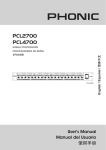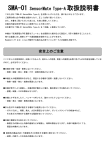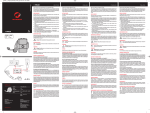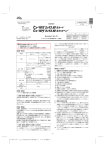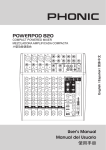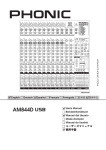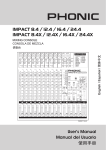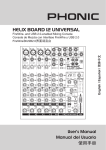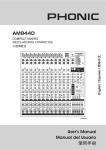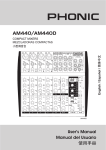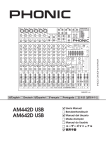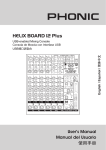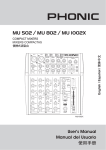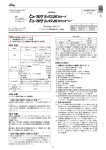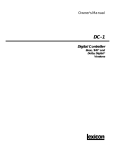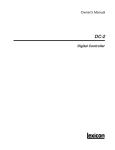Download AM2442FX AM3242FX
Transcript
AM2442FX AM3242FX MIXING CONSOLE WITH DFX AND GEQ CONSOLA DE MEZCLA CON DFX Y GEQ English / Español / 简体中文 内置数字EFX和GEQ的录音/现场制作调音台 AM3242FX User’s Manual Manual del Usuario 使用手册 AM2442FX/AM3242FX Mixing Console with DFX and GEQ Consola de mezcla con DFX y GEQ 内置数字EFX和GEQ的录音/现场制作调音台 CONTENTS CONTENIDO 目录 INTRODUCTION 4 INTRODUCCION 14 简介 24 FEATURES 4 CARCATERISTICAS 14 功能 24 GETTING STARTED 4 INICIANDO 14 开始设定 24 INPUTS AND OUTPUTS 5 ENTRADAS Y SALIDAS 15 输入和输出 24 21 规格 29 SPECIFCATIONS 11 ESPECIFICACIONES DIGITAL EFFECT TABLE 31 TABLA DE EFECTOS DIGITALES31 数字效果表 31 APPLICATION 32 APLICACIÓN 32 应用 32 DIMENSIONS 33 DIMENSIONES 33 尺寸 33 BLOCK DIAGRAMS 34 DIAGRAMAS DE BLOQUE 34 线路图 34 Phonic preserves the right to improve or alter any information within this document without prior notice Phonic se reserva el derecho de mejorar o alterar cualquier información provista dentro de este documento sin previo aviso PHONIC保留不预先通知即可更新本文件的权利 V1.1 07/08/2011 IMPORTANT SAFETY INSTRUCTIONS The apparatus shall not be exposed to dripping or splashing and that no objects with liquids, such as vases, shall be placed on the apparatus. The MAINS plug is used as the disconnect device, the disconnect device shall remain readily operable. Warning: the user shall not place this apparatus in the can be easily accessible. area during the operation so that the mains switch 1. Read these instructions before operating this apparatus. CAUTION 2. Keep these instructions for future reference. RISK OF ELECTRIC SHOCK DO NOT OPEN 3. Heed all warnings to ensure safe operation. 4. Follow all instructions provided in this document. 5. Do not use this apparatus near water or in locations where condensation may occur. 6. Clean only with dry cloth. Do not use aerosol or liquid cleaners. Unplug this apparatus before cleaning. 7. Do not block any of the ventilation openings. Install in accordance with the manufacturer’s instructions. 8. Do not install near any heat sources such as radiators, heat registers, stoves, or other apparatus (including . 9. Do not defeat the safety purpose of the polarized or grounding-type plug. A polarized plug has two blades with one wider than the other. A grounding type plug has two blades and a third grounding prong. The wide blade or the third prong is provided for your safety. If the provided plug does not into your outlet, consult an electrician for replacement of the obsolete outlet. 10. Protect the power cord from being walked on or pinched particularly at plug, convenience receptacles, and the point where they exit from the apparatus. 11. Only use attachments/accessories manufacturer. by the 12. Use only with a cart, stand, tripod, bracket, or table by the manufacturer, or sold with the apparatus. When a cart is used, use caution when moving the cart/apparatus combination to avoid injury from tipover. 13. Unplug this apparatus during lighting storms or when unused for long periods of time. 14. Refer all servicing to service personnel. Servicing is required when the apparatus has been damaged in any way, such as power-supply cord or plug is damaged, liquid has been spilled or objects have fallen into the apparatus, the apparatus has been exposed to rain or moisture, does not operate normally, or has been dropped. CAUTION: TO REDUCE THE RISK OF ELECTRIC SHOCK, DO NOT REMOVE COVER (OR BACK) NO USER SERVICEABLE PARTS INSIDE REFER SERVICING TO QUALIFIED PERSONNEL The lightning flash with arrowhead symbol, within an equilateral triangle, is intended to alert the user to the presence of uninsulated “dangerous voltage” within the product’ magnitude to constitute a risk of electric shock to persons. The exclamation point within an equilateral triangle is intended to alert the user to the presence of important operating and maintenance (servicing) instructions in the literature accompanying the appliance. WARNING: To reduce the risk of or electric shock, do not expose this apparatus to rain or moisture. CAUTION: Use of controls or adjustments or performance of procedures other than those may result in hazardous radiation exposure. INTRODUCTION Congratulations on your purchase of the AM2442FX or AM3242FX mixers - stylish 24- and 32-input mixers with 16 and 24 balanced mic/line channels and four stereo line channels, combined to make versatile yet brawny mixer. A brand new line of mixers, the AM series broadens already impressive product line. The AM mixers include popular features that go further than most, such as the 100program Digital Effect Processor (with tap delay and tone generator built-in) driven by an extraordinary 32/40-bit DSP engine. Featuring full gain ranges, low distortion and an incredibly wide dynamic range, the AM mixers are bound to make an impression. We know how eager you are to get started – wanting to get the mixer out and hook it all up is probably your number one priority right now – but before you do, we strongly urge you to take a look through this manual. Inside, you will find important facts and figures on the set up, use and applications of your brand new mixer. If you do happen to be one of the many people who flatly refuse to read user manuals, then we just urge you to at least glance at the Instant Setup section. After glancing at or reading through the manual (we applaud you if you do read the entire manual), please store it in a place that is easy for you to find, because chances are there’s something you missed the first time around. FEATURES GETTING STARTED Quick Setup 1. Ensure all power is turned off on your mixer. To totally ensure this, the AC cable should not be connected to the unit. 2. All faders and level controls should be set at the lowest levels to ensure no sound is inadvertently sent through the outputs when the device is switched on. All levels can be altered to acceptable degrees after the device is turned on using the channel setup instructions. 3. Plug any necessary equipment into the device’s various outputs. This could include amplifiers and speakers, monitors, signal processors, and/or recording devices. 4. Plug the supplied power supply into the inlet on the back of the AM mixer and into an AC power outlet of a suitable voltage. 5. Turn the power switch on and follow the channel setup instructions to get the most out of your equipment. Channel Setup 1. To ensure the correct audio level of the input channel is selected, each of the level input controls of the Mixer should be turned counterclockwise as far as they will go (which should be the -∞ mark). 2. Set the level control of the channel you are setting to the 0 dB mark. 3. Ensure the channel has a signal sent to it similar to the signal that will be sent when in common use. For example, if the channel is using a microphone, then you should speak or sing at the same level the performer normally would during a performance; if a guitar is plugged into the channel, then the guitar should also be strummed as it normally would be (and so on). This ensures levels are completely accurate and avoids having to reset them later. 4. Push to Solo button of the channel you wish to set. You should now be able to see the channel’s signal in the level meter. l Audiophile quality preamp design l DFX, 32/40-bit digital multi-effect processor with 100 programs. l 16 or 24 mic/line channels with inserts l 3-band EQ with swept mid-range l 75Hz low-cut filter on each mono channel l 4 AUX send mixing bus l AUX 1 & 2 with pre/post switch l 4 subgroups and additional mono output with sweepable low pass filter for subwoofer application 5. l Clip indication and gain level set LEDs plus mute switches for each channel Engage the Solo / PFL button below the level meter, allowing you to see the input channel’s pre-fader signal. 6. l Balanced main mix outputs with XLR and 1/4” TRS connectors, headphone/control room output and stereo tape outputs Adjust the gain level of the selected channel so that the level meter sits around the 0 dB mark. 7. l Solo-In-Place and Pre-Fader-Listen functions plus full-featured talkback section This channel is now ready to be used; you can stop making the audio signal. 8. You can repeat the same process for other channels. l Standby switch mutes all channels during breaks while background music is provided via CD/tape inputs AM2442FX / AM3242FX INPUTS AND OUTPUTS 7. Mid Frequency Control Mono Input Channels There are 16 and 24 mono channels on the AM2442FX and AM3242FX, respectively. To follow you will find details on how these channels work; how to make a connection, how to adjust the various controls, and how to ensure you get those most out of your mixer. 1. Microphone Input These jacks accept typical 3-pin XLR inputs for balanced and unbalanced signals. They can be used in conjunction with microphones – such as professional condenser, dynamic or ribbon microphones - with standard XLR male connectors, and feature low noise preamplifiers, serving for crystal clear sound replication. NB. When these inputs are used with condenser microphones, the Phantom Power should be activated. However, when Phantom Power button is engaged, single ended (unbalanced) microphones and instruments should not be used on the Mic inputs. 1 You can provide a peaking style of boost and cut to the level of midrange frequency sounds at a range of ±15 dB with this control. The AM mixers also provide a sweep control, allowing you to select a center frequency between 100 Hz and 8 kHz. Changing middle frequencies of an audio feed can be rather difficult when used in a professional audio mix, as it is usually more desirable to cut middle frequency sounds rather than boost them, soothing overly harsh vocal and instrument sounds in the audio. 8. Low Frequency Control This control is used to give a shelving boost or cut of ±15 dB to low frequency (80 Hz) sounds. This will adjust the amount of bass included in the audio of the channel, and bring more warmth and punch to drums and bass guitars. 9. AUX Controls 2 3 2. Line Input This input accepts typical 1/4” TRS or TS inputs, for balanced or unbalanced signals. There are various numbers of these inputs depending which mixer you are using. They can be used in conjunction with various line level devices, such as keyboards, drum machines, electric guitars, and a variety of other electric instruments. 3. Insert Point Located on all mono channels, the primary use for these TRS phone jacks is for the addition of external devices, such as dynamic processors or equalizers, to the corresponding mono input channel. This will require a Y cord that can send and receive signals of the mixer to and from an external processor. These four AUX controls alters the signal level that is being sent to the auxiliary 1 to 4 mixing buses, the signal of which is suitable for connecting stage monitors, allowing artists to listen to music that is being played. AUX 1 and 2 feature a Pre/Post button, which alternates the feed to the AUX mixing bus between a post and pre-fader feed. AUX 3, on the other hand, acts as an EFX send, the signal of which can be used in conjunction with external signal processors (which can be returned to the mixer via the AUX return input), or simply as an Auxiliary output. Both the AUX 3 (EFX) and AUX 4 controls are post fader and are sent directly to the corresponding outputs. 10. AUX Pre/Post Button This button allows users to switch the signal sent to the AUX 1 and AUX 2 mixes from the corresponding input channel between a pre fader and post fader signal. Pushed in, the signal is post-fader; released, it’s a pre-fader signal. 11. Pan Control This alternates the degree or level of the mono audio signal that the left and right channels of the main mix should receive. 4. Gain Control This controls the sensitivity of the input signal of the Line and Microphone inputs of mono channels. The gain should be adjusted to a level that allows the maximum use of the audio, while still maintaining the quality of the feed. This can be accomplished by adjusting it to a level slightly below that which will cause the peak indicator to light up. 5. Low Cut Filter Located on all mono channels, this button will activate a high-pass filter that reduces all frequencies below 75 Hz at 18 dB per Octave, helping to remove any unwanted ground noise or stage rumble. Stereo channels does not feature this low cut filter. 4 5 6 10 9 7 6. High Frequency Control Use it to give a shelving boost or cut of ±15 dB to high frequency (12 kHz) sounds. This will adjust the amount of treble included in the audio of the channel, adding strength and crispness to sounds such as guitars, cymbals, and synthesizers. AM2442FX / AM3242FX 8 11 12. Mute Button and Indicator Pushing the Mute button in will cut off the main mix’s feed of the corresponding channels signal. If the AUX pre/post button is set to post, the AUX 1 and 2 signals will also be cut off. Muting an input channel is accompanied by the lighting up of the Mute LED. 13. Clip LED This LED indicator will illuminate when the channel hits high peaks, slightly before the signal is dynamically clipped. It is best to adjust the channel’s level control so as to ensure the Clip indicator does not light up. This will ensure a greater dynamic range of audio. This indicator also doubles as a Solo indicator, when the Solo button is engaged. 12 13 14 15 16 17 14. Solo Button The Solo button is pushed to allow the signal of the corresponding channel to be sent to the Control Room / Phones mix (pre or post fader, depending on the properties selected by the Solo/PFL button located below the level meter), for use with either headphones or studio monitors. This button also allows for easier isolation of individual channel signals, enabling simpler setting of the input gain or tracking of audio by sound engineers. When the Solo button is not engaged, the LED indicator works as a Clip Indicator, illuminating when the signal reaches high peaks. 15. 1-2 and 3-4 Buttons These two buttons allow users to route the channel’s signal to their respective subgroups. There are four subgroups in total. If users wish to send the channel’s signal to, say, sub 1 but not sub 2, simply use the channel’s pan (turn it hard to the left) to accomplish this. 19. 4-Band Equalizer The stereo channels of the AM mixers feature equalizer almost identical to those on mono channels; however instead of a Mid frequency control and sweep control there are High-Mid and Low-Mid controls instead. They provide a peaking style of boost and cut to middle frequencies, where the frequencies are set at 3 kHz and 800 Hz for the High- and Low-Mids respectively. 19 20. AUX Controls The AUX controls on stereo channels are the same as on mono channels, however, since the AUX mixes are always mono, any stereo signal will be mixed into a mono signal before being sent to the corresponding AUX mix. 21. Balance Control This rotary control alternates the degree or level of audio that the left and right side of the main mix should receive. Adjusting the balance control will attenuate the left or right audio signals of the channel accordingly. 22. Mute and Routing Buttons The Mute, Main, 1-2 and 3-4 buttons on stereo channels do not differ in their operation to mono channels at all. However, it is important to make sure that when the 1-2 and/or 3-4 buttons are pushed that the Balance control is set to the middle, as this will ensure the stereo signal remains a stereo signal. 23. Stereo Channels 21/22 and 23/24(AM2442FX) Stereo Channels 29/30 and 31/32(AM3242FX) The final 2 stereo channels on both AM mixers feature slightly simplified controls. Here you will find two AUX sends (permanently wired to be pre-fader, useful in monitoring), a level control and Solo button. As there are no routing switches, the signal is permanently sent to the Main mix (and appropriate AUX mixes). 16. Main Button Pushing this button in allows the channel’s signal to be sent to the Main mix. 17. Channel Fader 21 This control will alter the signal level that is sent from the corresponding channel to the corresponding mixing buses. Stereo Input Channels Stereo channels differ slightly to the mono channels in their connections and controls. To follow you will find a run-down on the differences and what these channels are actually good for. 23 20 22 18. Stereo Inputs The AM mixers each feature 4 stereo input channels, the inputs of which differ slightly to the mono channels. The two 1/4” TRS inputs are for the addition of various stereo line level input devices, such as keyboards or drum machines. If you wish to use a monaural device on a stereo 18 return input, simply plug the device’s 1/4” phone jack into the left (mono) stereo input and leave the right input bare. The signal will be duplicated to the right due to the miracle of jack normalizing. AM2442FX / AM3242FX Subgroups 30. Mono Output The Subgroups on the AM mixers allow users to create single mono or stereo mixes of multiple input channels and control them with a single fader. It is also common to use the Group outputs as tape-outputs for connecting to multi-track recorders. 24. Solo Buttons The solo button allows the Group signal to be sent pre or post fader (depending on the SOLO/PFL button settings) to the Control Room / Phones mix, allowing users to be able to monitor the subgroup signal. When activated, the Solo LED will light up to indicate as such. 24 Handy in studios or on stage, the talkback function built into the AM mixers allows engineers or producers – anyone, really – to communicate with the performers wherever they may be. 25 31. Talkback Level Control The Group Controls also feature individual left and right buttons, which allow you to send the various Group signals to the Main Left 26 and Right. This can be handy when wanting to combine the signals from different signals and control their input levels simultaneously, then send them to the Main L/R signal (eg. when multiple inputs are used for, say, drums, you can combine these inputs together to be controlled much simpler by a single fader). 26. Faders These four faders are the final level control for the Group 1 to 4 audio feeds, sent to the corresponding Group outputs on the rear of the AM mixers to feed external devices such as effect processors, and, most commonly, multi-track recorders. The Group mix can be fed a signal from the various mono and stereo channels, as well as the EFX signal, depending on your selections. When pushed all the way up, these faders provide 10 dB of gain to the signal, and, when set all the way down, effectively mute the signal. 27. Group Outputs 27 This control adjusts the level of the talkback signal that is sent to the AUX 1 and AUX 2 outs. 31 32. Talk to AUX Button Holding this button down activates the AM’s built-in talkback microphone, the signal of which is sent to the AUX 1 and 2 outputs. Keep the button pushed down until you finish speaking. 32 33 33. Talkback Mic Point your mouth here when wishing to communicate with the performer/musician. Control Room & Phones The Control Room and Phones mixes are useful for monitoring of audio signals. It is important to remember, particularly when using headphones, that listening to excessively loud audio signals for prolonged periods of time could adversely affect your hearing. 34. Level Control This rotary control will allow users to adjust the audio level of the Control Room / Phones signal (as received by input channels, and those chosen by the Source Select buttons). If active monitors are used with the Control Room / Phones output, then this control acts as the monitor level control. 35. Source Select This set of buttons allows users to select which signals they wish to send to the Control Room / Phones output. There is a button each for the AUX 1/2, CD/Tape, 1-2, 3-4 and Main mixes. These signals can be monitored simultaneously, if wished. Mono / Subwoofer Channel The Mono output is used as an auxiliary output (the signal of which is taken from the main mix), and can be connected to an amplifier and speakers. The included low pass filter enables the signal of the mono output to be more appropriate for use with a subwoofer speaker, to add a little extra bass to your sound. 30 Talkback Section 25. Left / Right Buttons These 1/4” phone jacks output the final feed from the Group mixes 1, 2, 3 and 4, the level of which is determined by the Group Faders. They can be used to feed a variety of recording and PA devices, including multi-track recorders, amplifiers and speakers, etc. The line-level signal sent from the Mono output can be used to connect to an amplifier or active speaker. It is also possible to use this output for monitoring purposes, with headphones or active monitors. 36. Control Room / Phones Output 28 This 1/4” outputs feeds the signal altered by the Control Room / Phones level control on the face of the mixer to an external speaker or headphones. This output has extensive use, as it can be used to feed the signal from the mixer to an active monitor, for the monitoring of the audio signal from within a booth, among many other possible uses. 28. Low Pass Filter The low pass filter is activated by moving the small slide switch to the ON position. The accompanying control allows users to adjust the cut-off frequency of the filter. If users wish to use the Mono channel for monitoring or other similar purposes, the low pass filter should not be activated. 29. Mono Fader 34 35 36 29 This fader controls the level of the mono signal that is sent to the mono outputs. AM2442FX / AM3242FX CD/Tape Ins & Outs Graphic Equalizer The CD/Tape section allows for external consumer-level devices, such as CD players or tape recorders, to be incorporated into the mixer. The 9-band graphic equalizer will allow users to alter the various frequencies of the audio in their Main or AUX 1 mixes, for reducing feedback and adapting audio to suit room acoustics. 37. To Main Control 43. Equalizer This control adjusts the level of the signal received through the CD inputs that is sent to the Main mix. This stereo 9-band equalizer allows users to cut and boost the indicated frequencies by 12 dB. When the FBD (feedback detection) button is in the ‘in’ position, these sliders will light up to indicate that the corresponding frequency may be causing feedback or have the potential to cause feedback. This allows users to reduce the level to avoid feedback from occuring. 37 38. Standby Button The Standby button is used to mute all input 38 channels of the AM mixers. In this instance, the CD/Tape input will still be in use, allow music to be played between sets while ensuring no microphones inadvertently pick up any audio. The main level fader can remain in its normal position, ensuring you don’t lose your mix. 39. CD / Tape Ins & Outs 44. FBD In Button Push this button to activate the feedback detection circuit. This allows the sliders on the EQ to illuminate problem frequencies. 45. Main / AUX Button This button determines which signal will be processed by the graphic equalizer. The AUX 1/2 and Main signals are selectable. These stereo RCA connectors allow users to send signals to and from the mixer, allowing devices such as CD players and tape recorders/ players to be used in conjunction with your setup. Signals received by the CD/Tape inputs are adjusted by the “to Main” control. 46. EQ In Switch Pushing this switch will turn the graphic equalizer on and off. 44 39 Auxiliary Section The Auxiliary outputs are included on this mixer as a way to enable users to have a secondary signal for whatever purpose necessary, whether it be for connecting to signal processors or to active monitors. 45 46 43 40. AUX Send Controls Digital Effect Processor These three controls are for adjusting the audio level that is sent to the corresponding AUX outputs, the signal of which is initially taken from each channel’s individual AUX send controls. Pushing the accompanying SOLO button will send the three AUX sends to the Control Room / Phones mix (pre or post fader, depending on the Solo / PFL button) and be accompanied by an illuminated LED. The built-in digital effect processor encompasses a 32/40-bit digital processor and features 100 preset programs, as well as various test-tones and tap-delay. For a completel list of effects, please observe the Digital Effects Table. 41. AUX Send Outputs These four 1/4” phone jacks will output the corresponding AUX send signals These can be connected to external processing devices, and subsequently returned to the AUX Return inputs. They may also be used with active monitors, if required. 42. AUX Return Inputs These four 1/4” phone jacks make up 2 stereo AUX return inputs. They can be used to return a signal to the mixer that has been sent to an external processing device and send the signal to the Main mix. This 2-digital numeric display shows the program number that is currently applied to your EFX audio signal. When you rotate the Program control, you can scroll through different program numbers; however the display will revert back to the original program if a new program is not selected within a few seconds. 48. Sig and Clip Indicators Located within the Digital Effect Display are Clip and Sig LEDs. The Sig LED will light up when any signal is received by the effect processor, and the Clip LED will light up shortly before excessive signals are dynamically clipped. If the Clip LED lights up too often, it may be advisable to turn down one or all EFX controls on input channels to ensure the signal level is not too high. 50 40 42 47. Digital Effect Display 49 48 47 41 AM2442FX / AM3242FX 49. Program Control This control is used to scroll through the various effects. Turning the control clockwise will allow users to ascend into higher program numbers, and turning it counter-clockwise will allow users to descend into lower program numbers. Pushing this control will apply the new effect. When a tap-delay effect is selected, pressing this control will allow users to select the tap-delay time. By pushing the button several times, the effect processor interprets the time between last two pushes and remembers this as the delay time, until the button is pushed again (this is kept, even after the power is turned off). When the tap delay effect is selected, a small LED will flash within the digital effect display window at the selected intervals. 50. EFX Send Control This rotary control will adjust the level of the output signal at the AUX 4 send jack, as well as determine the amount of audio the built-in effects processor will receive. When this control is set to it’s minimum position, neither the AUX 4 send nor the effect processor will receive a signal. 50 49 48 47 51. FX to AUX 1 Control This control allows users to send the signal processed by the effects processor to the AUX 1 send mix, allowing for monitoring of the signal. 52. FX to AUX 2 Control This control allows users to send the signal processed by the effects processor to the AUX 2 send mix, allowing for monitoring of the signal. 53. FX to Main Control The FX to Main control will allow users to adjust the EFX signal that is sent to the Main or Group 1/2 mixes, as determined by the Main/Group button. 54. Main / Group Buttons Master Section The master section of the mixer features all the goodies: the level meter, main level fader, +48V and power indicators, the solo/PFL button, and so on and so forth. This is where a lot of the magic happens, so take care not to miss anything. 56. +48V Indicator This LED indicator will light up when Phantom Power is activated. To turn the AM’s Phantom Power on or off, simply flick the switch on the rear of the mixer. 56 57 57. Power Indicator The Power Indicator will light up when the power of the mixer is on. 58 58. Level Meter The dual 12 segment level meter gives an accurate indication of when audio levels of the Main L/R signal reach certain levels. The 0 dB indicator illuminates is 59 approximately equal to an output level of +4 dBu (balanced), and the PEAK indicator illuminates about 1.5 dB before the signal is dynamically clipped. It is advised that users set the various level controls so that the signal level sits steadily around the 0 dB mark, to make full use of audio while still maintaining fantastic clarity. 59. Solo / PFL Switch Located underneath the Level Meter, this button alters the Solo signals received by the Control Room / Phones mix between Post (solo) and Pre (PFL) fader signals. Whether set to Solo or PFL, one of the corresponding LED indicators will light up to indicate the current setting. If adjusting a signal with the Control Room / Phones level control, it is advisable that this button is set to Solo, ensuring the signal is independent of any channel faders. 60. Main Fader The Left and Right main mix is controlled with this fader – the final level control for the Main Left and Right audio feeds, sent to the Main L and R outputs. When pushed all the way up, the Main L/R fader provides 10 dB of gain to the signal, and when set all the way down, the signal is effectively muted. These button on the left (Main L/R / Group) allows users to send the signal processed by the effect processor to either the Main or Group mixes. If this button is set to Group, using the Group 1/2 / Group 3/4 button will determine which of the group mixes the signal will be sent. If the Main L/R / Group button is set to Main, the Group 1/2 / Group 3/4 button will be rendered useless. 51 52 53 54 60 55. Footswitch Jack The foot switch port is for the inclusion of a foot switch, used for remote activation and deactivation of the built-in Digital Effect processor. 55 AM2442FX / AM3242FX 61. Main Outputs These outputs will output the final stereo line level signal sent from the main mixing bus. The primary purpose of the two XLR jacks is to send the main output to external devices, which may include power amplifiers (and in-turn, a pair of speakers), other mixers, as well as a wide range of other possible signal processors (equalizers, crossovers, etcetera). The two 1/4” phone jacks are able to send the Main output to external devices that may run in parallel with the mixer. This may include additional power amplifiers, mixers, PA systems, as well as a wide range of other possible signal processors. 62. Main Insert Point Like the Insert Points on input channels, the primary use for these TRS phone jacks is for the addition of external devices, such as dynamic processors or equalizers, to the Main L and R mix. This will require a Y cord that can send (pre-fader) and receive signals to and from an external processor. When the main insert is in use, it will affect the signal sent to both the 1/4” and XLR main outputs. Rear Panel 63. Phantom Power When this switch is in the on position, it activates +48V of phantom power for all microphone inputs, allowing condenser microphones (well, the ones that don’t use batteries) to be used on these channels. Activating Phantom Power will be accompanied by an illuminated LED above the left channel Level Meter. Before turning Phantom Power on, turn all level controls to a minimum to avoid the possibility of a ghastly popping sound from the speakers. NB. Phantom Power should be used in conjunction with balanced microphones. When Phantom Power is engaged, single ended (unbalanced) microphones and instruments should not be used on the Mic inputs. Phantom Power will not cause damage to most dynamic microphones, however if unsure, the microphone’s user manual should be consulted. 64. Power Switch You can use it to turn the mixer on and off. Ensure you turn all level controls down before activating. 65. Power Connector Used for the addition of a power cable and supply, allowing power to be supplied to the mixer. Please use the power cable that is included with this mixer only. The Fuse holder, located above the AC Power connector, is, of course, for the AM mixer’s fuse. If the fuse happens to blow, open the holder cover, and replace the fuse with a suitable replacement (as indicated on the fuse holder’s cover). 62 61 65 10 64 63 AM2442FX / AM3242FX SPECIFICATIONS Model AM2442FX AM3242FX Total Channels 24 32 Balanced Mono Mic / Line Channel 16 24 Inputs Balanced Stereo Line Channel 4 Aux Return 4 2T Input 2 Outputs Main L/R Stereo Rec Out 2, (2*XLR, 2*1/4" TRS) 2, RCA CTRL RM/PHONES 1, (1/4" TRS) Mono (Sub) Out 1, (1/4" TRS) Group Out 4 ( 4*1/4"TRS) Channel Strips EFX Send 1 Pan/Balance Control 1 Volume Controls AUX Send Inserts 60mm fader 4 (Pre/Post switch on Aux 1/2) 1 Master Section Phones Level Control Mono (Sub) Out Main L/R Level Control 1 (Rotary control with route switch) 60mm fader with sweptable LP 60mm fader Metering Number of Channels 2 Segments 12 Phantom Power Supply 48VDC Frequency Response (Mic input to any output) 20Hz ~ 40KHz 0/-1dB 10Hz ~ 200KHz 0/-3dB Crosstalk (1KHz @ 0dBu, 20Hz to 20KHz bandwidth, channel in to main L/R outputs) Channel fader down, other channels at unity <-90dB Noise (20Hz~20KHz; measured at main output, Channels 1-4 unit gain; EQ flat; all channels on main mix; channels 1/3 as far left as possible, channels 2/4 as far right as possible Master @ unity, channel fader down -96dB Master @ unity, channel fader @ unity -84dB S/N ratio, ref to +4 -105dB AM2442FX / AM3242FX 11 Microphone Preamp E.I.N. (150 ohms terminated, max gain) <-123dBu THD (Any output, 1KHz @ +14dBu, 20Hz to 20KHz, channel inputs) <0.014% Maximum Level Mic Preamp Input +12dBu All Other Input +22dBu CTRL RM/PHONES +17dBu/150ohms Balanced Output +20dBu Impedance Mic Preamp Input 2.5k ohms Mono Line Input 21k ohms Stereo Line Input >10k ohms AUX RTN >10k ohms RCA 2T Input >10k ohms All Other Output (except REC Out, Phones Out) 120 ohms CD/TAPE out 1.6k ohms Phones Out 100 ohms Equalization 3-band +/-15dB Low EQ 80 Hz Mid EQ Sweptable 100Hz~8k Hz Hi EQ 12k Hz Low Cut Filter 32/40-bit Digital Effect Processor Power Requirement Weight Dimensions (WxHxD) 12 75Hz (-18 dB/oct) 100 effects with tap delay control 100-240V~, 50-60Hz, 50W appox. 8.5Kg appox. 11.5Kg 682X100X410mm 896X100X410mm AM2442FX / AM3242FX INTRODUCCION INICIANDO Queremos felicitarle por su compra de las mezcladoras AM2442FX o AM3242FX elegantes de 24 y 32 entradas con 16 y 24 canales de mic/línea balanceados y 4 canales de línea estéreo, combinadas con muchas características para hacer una mezcladora versátil y útil. Una nueva línea de mezcladoras, la serie AM da una impresionante línea de productos. Las mezcladoras AM incluyen características populares que van más allá de las regulares, como el Procesador de Efectos Digitales con 100 programas (con Tap Delay y generador de tono integrado), procesado por un poderoso DSP a 34/40 bits. Con rangos de ganancia completos, baja distorsión y un increíble rango dinámico, las mezcladoras AM tienen mucho para impresionarle. Configuración Rápida Nosotros sabemos que está impaciente por sacar la mezcladora y conectar todo que seguramente es su única prioridad en estos momentos - pero antes de hacerlo, le pedimos encarecidamente darle un vistazo a este manual. Dentro encontrará hechos importantes con imágenes de la configuración, uso y aplicaciones de su nueva mezcladora. Si usted resulta ser de esas personas que se niega totalmente a leer los manuales, entonces solo le pediremos que lea la sección de Configuración Rápida. Después de que le dé un vistazo o lea todo el manual (le felicitamos si lee todo el manual), por favor guárdalo en un lugar donde pueda encontrarlo fácilmente, esto por que puede suceder que no recuerde algo de la primera vez que leyó este documento. CARCATERISTICAS Diseño de preamp de calidad de audiofilo DFX, procesador digital multi-efecto a 32/40-bits con 100 programas 16 o 24 canales de micrófono/línea con inserts EQ de 3 bandas con barrido en medias Filtro de corte bajo a 75Hz en cada canal mono 4 buses de mezcla de envío AUX AUX 1 & 2 con selector pre/post 4 subgrupos y salida mono adicional con filtro paso bajo barrible para aplicaciones de subwoofer LEDs de indicación de Recorte (Clip) y de nivel de ganancia más selectores MUTE para cada canal Salidas de mezcla principal balanceada con conectores XLR y 1/4” TRS, salida de audífonos/control room y salidas estéreo de Tape 1. Asegúresee de que la mezcladora esté completamente apagada. Para asegurarse de eso, el cable de AC no debe de estar conectado a la unidad. 2. Todos los faders y todos los controles deben de estar en el nivel más bajo para asegurar que ningún audio sea enviado a las salidas cuando se prenda el equipo. Todos los niveles pueden ser modificados a niveles aceptables después de que se encienda el equipo utilizando las instrucciones de configuración de canal. 3. Conecte todo el equipo necesario en las varias salidas de la mezcladora. Esto puede incluir amplificadores, altavoces, monitores, procesadores de señal y/o dispositivos de grabación. 4. Conecte el cable de AC suministrado al conector en el dorso de la mezcladora AM y a una tomacorriente de voltaje compatible. 5. Apaggue la unidad y siga las instrucciones de configuración de canal para obtener lo mejor de su mezcladora. Configuración de canal 1. Para asegurar que se seleccionó el nivel correcto de audio del canal de entrada, cada uno de los controles de nivel de entrada de la mezcladora deberán estar en su mínima posición (que deberá ser la marca -∞). 2. Coloque el control del nivel de canal que desea ajustar a la posición de 0dB. 3. Asegúrese de que el canal tenga un nivel similar de señal igual al que se utilizará en modo común. Por ejemplo, si el canal está utilizando un micrófono, entonces deberá hablar o cantar al mismo nivel que el cantante normalmente lo haría durante una presentación; si una guitarra es conectada dentro del canal, entonces la guitarra deberá ser tocada al nivel que generalmente deberá ser (y así). Esto asegura que los niveles están completamente precisos y evita tener que reiniciarlos después. 4. Presiona el selector SOLO del canal que desea ajustar. Deberá poder ya ver la señal del canal en el medidor de nivel. 5. Active el botón Solo/PFL que está debajo del medidor de nivel, permitiéndole así ver la señal pre-fader del canal. 6. Ajuste el nivel de ganancia de canal seleccionado de tal manera que el medidor de nivel indique un nivel alrededor de los 0dB. 7. Este canal ya está listo para ser utilizado, puede dejar de hacer la señal de prueba. 8. Puede repetir el mismo proceso para otros canales. Funciones de Solo-In-Place y Pre-Fader-Listen además de una sección con muchas funciones de talkback Selector de Standby que cancela (mute) todos los canales durante pausas mientras que se provee de música de fondo vía las entradas de CD/TAPE 14 AM2442FX / AM3242FX ENTRADAS Y SALIDAS 7. Control de Frecuencias Medias Canales de Entrada Mono Se tienen 16 y 24 canales mono en la AM2442FX y AM3242FX respectivamente. Para continuar, encontrará detalles en cómo estos canales funcionan, cómo hacer una conexión, cómo ajustar los diferentes controles y cómo asegurarse de obtener lo más de su mezcladora. 1. Entradas de Micrófono Estos jacks aceptan entradas típicas XLR a 3 pins para señales balanceadas y desbalanceadas. Pueden ser utilizadas con micrófonos- profesionales de condensador, dinámicos o ribbon- con conectores estándar XLR machos y, tienen pre-amplificadores de bajo ruido, que sirven para reproducción cristalina del audio. NOTA. Cuando estas entradas se utilizan con micrófonos de condensador, deberá activarse la fuente fantasma. Sin embargo, cuando la fuente fantasma está activada, no deberá de conectarse micrófonos de un extremo (desbalanceados) y los instrumentos no deberán ser conectados a las entradas de micrófono. Este control se utiliza para proveer un refuerzo estilo pico y recorte del nivel de las frecuencias medias (2.5kHz) en un rango de ±15 dB. Las mezcladoras AM también proporcionan un control del barrido, permitiendole seleccionar una frecuencia de centro entre 100 Hz y 8 kHz. Cambiar las frecuencias medias del la alimentación del audio puede ser difícil si se utiliza en una mezcla de audio profesional, debido a que usualmente es más deseable recortar los sonidos de frecuencias medias en vez de reforzarlas, reforzar los sonidos medios disparara los sonidos estridentes en las voces y en los instrumentos en el audio. 8. Control de Frecuencias Graves 1 Utiliza este control para dar un realce tipo Shelving o un recorte de ±15dB a los sonidos de frecuencias bajas (80Hz). Esto ajustará la cantidad de bajos incluidos en el audio del canal y ofrecerá mas calidez y punch a las baterías y a los bajos. 2 9. Controles AUX 3 2. Entradas de Línea Esta entrada acepta entradas típicas 1/4” TRS o TS, para señales balanceadas o desbalanceadas. Hay varias de estas entradas dependiendo de la mezcladora que está usando. Pueden utilizarse con un amplio rango de equipos de nivel de línea como teclados, cajas de ritmos, guitarras eléctricas y una gran variedad de instrumentos electrónicos. 3. Puntos de Insert Localizado en todos los canales mono, el uso principal de estos jacks TRS es para agregar dispositivos externos, como procesadores dinámicos o ecualizadores, al canal correspondiente de entrada mono. Esto requerirá de un cable Y que pueda enviar y recibir señales de mezcladora desde y a un procesador externo. 4. Control de Ganancia Controla la sensibilidad de la señal de entrada del canal de Línea y de Micrófono de los canales mono. La ganancia deberá ajustarse a un nivel que permita el máximo uso del audio, mientras que se mantenga la calidad de la alimentación. Esto puede lograrse al ajustarlas a un nivel ligeramente por debajo del cual se active el indicador de pico. Estos cuatro controles AUX alteran el nivel de la señal que es enviado a los buses de mezcla AUX 1 y 4, cuya señal es adecuada para conectar monitores de escenario, permitiendo así a los artistas escuchar su música mientras es reproducida. Los AUX 1 y 2 tienen un selector Pre/Post, el cual alterna la alimentación a bus de mezcla entre señal pre fader o post fader. El AUX 3 por otro lado, actúa como un envío de EFX, cuya señal puede ser utilizada con procesadores de señal externo (la cual puede ser regresada a la mezcladora vía retorno AUX), o simplemente como una salida Auxiliar. Ambos controles AUX 3 (EFX) y AUX 4 son post fader y son enviados directamente a las salidas correspondientes. 10. Selector AUX Pre/Post Este selector permite a los usuarios cambiar la señal enviada a las mezclas AUX 1 y 2 desde los canales de entrada correspondientes entre una señal pre fader o post fader. Presionándolo la señal será post-fader, liberándolo la señal será pre-fader. 11. Control de Paneo Alterna el grado o nivel de la señal de audio mono que los canales izquierdo y derecho de la mezcla principal deberán de recibir. 4 5 6 5. Filtro de Corte Bajo Localizado en todos los canales mono, este botón activará un filtro de paso alto que reducirá todas las frecuencias debajo de los 75 Hz a 18 dB por octava, ayudando a remover cualquier ruido desagradable o vibraciones de piso. Los canales estéreo no presentan este filtro de corte bajo. 6. Control de Frecuencias Agudas Utiliza este control para dar un realce tipo Shelving o recorte de ±15 dB a los sonidos de altas frecuencias (12 kHz). Esto ajustará la cantidad de agudos incluidos en el audio del canal, agregando fortaleza y sonido cristalino a las guitarras, metales y sintetizadores. AM2442FX / AM3242FX 10 9 7 8 11 15 12. Botón Mute e Indicador Presionando el botón Mute, cortará la alimentación de la mezcla principal de señal de canales correspondientes. Si el selector pre/post AUX es colocado en la posición post, las señales AUX 1 y 2 también serán recortadas. Activando el selector Mute a un canal de entrada será acompañado de un indicador LED. 13. LED de Clip 12 13 14 15 16 Este indicador LED se iluminará cuando el canal alcance altos picos, ligeramente antes de que la señal sea recortada 17 dinámicamente. Es mejor ajustar el nivel del canal de tal manera que se asegure que el indicador de Clip no se ilumine. Esto asegurará un mayor rango dinámico en el audio. Este indicador también funciona como indicador SOLO, cuando el botón SOLO es activado. 14. Botón Solo El botón Solo es presionando para permitir que la señal del canal correspondiente sea enviada a la mezcla de Control Room/ Audífonos (pre o post fader dependiendo de las propiedades seleccionadas por el botón Solo/PFL ubicado debajo del medidor de nivel), para ser utilizado ya sea con audífonos o monitores de estudio. Este selector permite un fácil aislamiento de las señales individuales del canal, permitiendo un ajuste más sencillo de la ganancia de entrada o de rastreo de audio por los ingenieros de sonido. Cuando el selector de solo no está activado, el indicador LED funcionará entonces como indicador de Clip, iluminándose cuando la señal alcanza picos altos. 15. Botones 1-2 y 3-4 Estos dos botones permite a los usuarios a rutear la señal de canal a sus respectivos subgrupos. Se tiene de un total de 4 subgrupos. Si los usuarios quieren enviar la señal del canal a uno de ellos, digamos al sub 1 pero no al sub 2, simplemente utiliza el paneo del canal (colocándolo completamente a la izquierda) para lograr esto. 19. Ecualizador de 4 Bandas Los canales estéreo en las mezcladoras AM tienen un ecualizador casi idéntico a los de los canales mono; sin embargo, en lugar de un control de medios y control de barrido, se tienen controles de Medio-Alto y de Medio-Bajo. Estos dan un control estilo pico de refuerzo y recorte a las frecuencias medias, mientras que las frecuencias están a 3kHz y 800Hz para Medio-Alto y Medio Bajo respectivamente. 20. Controles AUX Los controles AUX en los canales estéreo son los mismos que los de los canales mono, sin embargo, debido a que las mezclas AUX siempre son mono, cualquier señal estéreo será mezclada en señal mono antes de ser enviada a la mezcla AUX correspondiente. 21. Control de Balance Este control giratorio alterna el grado o nivel de audio que el lado izquierdo o derecho de la mezcla principal deberá de recibir. Ajustando este control, atenuará la señal de audio izquierda o derecha de canal correspondiente. 22. Botones de Mute y Ruteo Los botones Mute, Main, 1-2 y 3-4 en los canales estéreo no difieren en la operación de los canales mono. Sin embargo, es importante asegurarse de que cuando los botones 1-2 y/o 3-4 están presionados, el control de Balance esté a la mitad, así se asegurará de que la señal estéreo permanecerá una señal estéreo. 23. Canales Estéreo 21/22 y 23/24 (solo en AM2442FX) Canales Estéreo 29/30 y 31/32 (solo en AM3242FX) Los 2 canales estéreo finales en ambas mezcladoras AM tienen controles simplificados. Aquí encontrará dos envíos AUX (permanentemente cableados como pre-fader, útil para monitoreo), un control de nivel y un botón Solo. Debido a que no se tienen ningún selector de ruteo, la señal es enviada permanentemente a la mezcla Principal (y mezclas AUX apropiadas). 16. Botón Main 21 Presionando este botón envia la señal del canal correspondiente a la mezcla principal. 17. Fader de Canal Este control alterará el nivel de la señal que es enviada desde el canal correspondiente a los buses de mezcla. 18. Entradas Estéreo 23 20 22 Canales de Entrada Estéreo Los canales Estéreo difieren ligeramente de los canales mono en sus controles y conexiones. A continuación encontrará una descripción de las diferencias y para qué son buenos estos canales. 19 18 Las mezcladoras AM tienen 4 canales de entrada estéreo, cuyas entradas difieren ligeramente de los canales mono. Las dos entradas 1/4” TRS son para agregar diferentes dispositivos estéreos de entrada de nivel de línea, como teclados o cajas de ritmos. Si desea utilizar un dispositivo monoaural en una entrada de retorno estéreo, simplemente conecte el jack 1/4” de dispositivo a la entrada izquierda (mono) estéreo y deja la entrada derecha sin conexión. La señal será copiada al canal derecho gracias a la magia de la normalización. 16 AM2442FX / AM3242FX Subgrupos 29. Fader Mono Los subgrupos en las mezcladoras AM permitirán a los usuarios crear mezclas mono o estéreo de múltiples canales de entrada y controlarlas con un solo fader. Es también muy común utilizar las salidas de Grupo como salidas-tape para conectar con grabadoras de multi-pista. 30. Salida Mono 24. Botones Solo El botón solo permite a la señal de Grupo ser enviada pre o post fader (dependiendo de lo seleccionado en SOLO/PFL) a la mezcla de Control Room/Phones, permitiendo a los usuarios ser capaces de monitorear la señales de subgrupo. Cuando se active, el indicador LED de Solo será activado. 24 25 25. Botones Izquierdo/Derecho Los controles de grupo también tienen botones individuales izquierdo y derecho, 26 los cuales le ayudan a enviar las diferentes señales de Grupo a la mezcla principal izquierda y derecha. Esto puede ser útil cuando se quiere combinar las diferentes señales y controlar sus niveles de entrada simultáneamente, y de ahí enviarlas a la señal de Main L/R (ej. cuando múltiples entradas son utilizadas para, digamos, batería, podrá combinarlas para ser controladas más sencillamente con un solo fader). 26. Faders Estos cuatro faders son el control final de nivel para las alimentaciones de audio de Grupo 1 a 4, enviadas a las salidas de Grupo correspondientes en la parte posterior de las mezcladoras AM para alimentar a dispositivos externos como procesadores de efecto y, más comunmente grabadoras de multi-pista. La mezcla de Grupo puede ser alimentada por una señal desde varios canales mono y estéreo, así como de la señal de EFX, dependiendo de sus selecciones. Cuando están completamente hacia arriba proveerán de 10 dB de ganancia a la señal, y cuando están completamente hacia abajo cancelaran efectivamente la señal. 27. Salidas de Grupo Estos jacks 1/4” darán la salida final de la mezcla de Grupo 1, 2, 3 y 4, cuyo nivel es determinado por los Faders de Grupo. Pueden ser utilizados para alimentar una variedad de dispositivos de grabación y de PA, incluyendo grabadoras multi-track, amplificadores, altavoces etc. 27 AM2442FX / AM3242FX 30 Sección de Talkback Útil en estudios o en el escenario, la función de talkback integrada a las mezcladoras AM permite a los ingenieros o productores –a cualquiera de hecho- comunicarse con el otro lado de la producción cuando sea necesario. 31 31. Control de Nivel de Talkback 32 Este control ajusta el nivel de la señal de talkback que es enviada a las salidas AUX 1 y 2. 33 32. Botón “Talk to AUX” Presionando este botón se activa el micrófono talkback integrado de la AM, la señal será enviada a las salidas AUX 1 y 2. Mantén este selector presionado hasta que termine de hablar. 33. Micrófono de Talkback Dirija su voz hacia este lugar cuando desea comunicarse con su actor/músico. Control Room & Phones Las mezclas de Control Room y de Audífonos son útiles para monitoreo de las señales de audio. Es importante recordar, particularmente cuando se utiliza audífonos, que escuchar un audio muy fuerte por períodos largos de tiempo puede afectar seriamente su audición. Este control giratorio permitirá a los usuarios ajustar el nivel del audio de la señal de Control Room/Phones (recibida por los canales de entrada, y aquellos escogidos por los botones de Selección de Fuente). Si se utilizan monitores activos con la salida de Control Room/Phones, entonces este control actuará como control de nivel de monitor. 35. Selección de Fuente 28 Este conjunto de botones permite a los usuarios seleccionar qué señales desean enviar a la salida de Control Room/Audífonos. Se tiene un selector para las mezclas AUX 1/2, CD/Tape, 1-2, 3-4 y Main. Estas señales pueden ser monitoreadas simultáneamente, si se desea. 36. Salidas de Control Room / Phones Estos jacks 1/4” de salida dan la señal alterada por el control de nivel de Control Room/Phones en la parte delantera de la mezcladora a un altavoz externo o audífonos. Esta salida tiene un uso extenso, puede utilizarse para alimentar la señal de la mezcladora a un monitor activo, para monitorear la señal de audio desde una cabina, entre muchos otros posibles usos. 28. Filtro Pasa Bajas El filtro pasa bajas es activado al mover el pequeño interruptor deslizable a la posición ON. El control que lo acompaña permitirá a los usuarios ajustar la frecuencia de corte del filtro. Si los usuarios desean utilizar el canal mono para monitoreo o cualquier uso similar, el filtro pasa bajas deberá ser desactivado. La señal de nivel de línea que es enviada desde la salida mono puede ser utilizada para conectar un amplificador o altavoz activo. También es posible utilizar esta salida para propósitos de monitoreo, con audífonos o con monitores activos. 34. Control de Nivel Canal Mono / Subwoofer La salida Mono es utilizada como una salida auxiliar (cuya señal es tomada de la mezcla principal), y puede ser conectada a un amplificador y altavoces. El filtro pasa bajas incluido permite que la señal de la salida mono sea más apropiada para utilizarse con altavoz subwoofer, para agregar un poco de sonido grave extra a su audio. Este fader controla el nivel de la señal mono que es enviada a las salidas mono. 29 34 35 36 17 Entradas/Salidas de CD/Tape Ecualizador Gráfico La sección de CD/Tape permite que dispositivos externos a nivel-consumidor, como reproductores de CD o de cinta, sean incorporados a la mezcladora. Este ecualizador gráfico de 9-bandas permitirá a los usuarios alterar las varias frecuencias de audio de mezclas Main o AUX 1, esto para reducir la retroalimentación y adaptar al audio para las características acústicas. 37. Control “To Main” 43. Ecualizador Este control ajusta el nivel de la señal recibida a través de las entradas de CD que son enviadas a la mezcla principal. 37 38. Botón Standby El botón Standby es utilizado para cancelar 38 todos los canales de entrada de las mezcladoras AM. En este caso, la entrada de CD/Tape seguirá en uso, permitiendo a los músicos reproducir música mientras que no se tenga otra señal en la mezcla. Puede dejar el fader de mezcla principal en su lugar, asegurando que no pierda su mezcla. 39. Entradas/Salidas de CD / Tape Este ecualizador estéreo de 9-bandas permite a los usuarios en atenuar o incrementar las frecuencias indicadas por 12 dB. Cuando el botón de FBD (detección de realimentación) está en la posición ¨ïn¨, estos deslizadores se iluminarán para indicar la frecuencia correspondiente que puede causar una realimentación o tiene posibilidad de causar realimentación. Esto permite a los usuarios en reducir el nivel para prevenir que ocurra realimentaciones. 44. Botón FBD Presione este botón para activar el circuito de detección de realimentación. Esto permite que los deslizadores en el EQ para iluminar la frecuencia con problemas. 45. Botón Main / AUX Estos conectores estéreo RCA permitirán a los usuarios enviar señales hacia y desde la mezcladora, permitiendo a dispositivos como reproductores de CD y grabadoras/ reproductores de tape sean utilizados junto con su configuración. Las señales recibidas por estas entradas son ajustadas con el control “to Main”. Este botón determina cual de las señales deber ser procesada por el ecualizador gráfico. Las señales de AUX 1/2 y Central (Main) son seleccionables. 46. Interruptor EQ 39 Presione este interruptor para activar o desactivar el ecualizador gráfico. Sección Auxiliar 44 Las salidas Auxiliar están incluidas en esta mezcladora como una manera de permitir a los usuarios tener una señal secundaria para cualquier propósito necesario, ya sea para conectar procesadores de señal o para conectar monitores activos. 45 46 40. Controles de Envío AUX Estos tres controles son para ajustar el nivel del audio que es enviado a las salidas AUX correspondientes, cuya señal es inicialmente tomada de cada control de envío AUX individual de canal. Presionando el botón de Solo que lo acompaña, enviará los tres envíos AUX a la mezcla de Control Room / Phones (pre o post fader, dependiendo del botón Solo / PFL) y está acompañado por un LED iluminado. 43 Procesador de Efectos Digitales El procesador de efectos digitales tiene un procesador digital a 32/40 bits y tiene 100 presets de programas, así como varios tonos de prueba de audio y tap delay. Para una lista completa de los efectos, por favor vea la Tabla de Efectos Digitales en este manual. 41. Salidas de Envío AUX 47. Display de Efectos Digitales Estos cuatro jacks 1/4” darán la salida de las señales de Envío AUX correspondiente. Estos pueden conectarse a dispositivos de procesamiento externos y, subsecuentemente regresado a las entradas de Retorno AUX. Esto también puede ser utilizado con monitores activos, de ser necesario. Este display numérico de 2 dígitos muestra el número de programa que está siendo aplicado a su señal de audio de EFX. Cuando gira el control de Program, podrá navegar entre los diferentes números de programas; sin embargo, el display se regresará al programa original rápidamente si no se selecciona uno nuevo. 42. Entradas de Retorno AUX 48. Indicadores de Señal (Sig) y de Recorte (Clip) Estos cuatro jacks 1/4” hacen dos entradas de retorno AUX estéreo. Pueden ser utilizadas para retornar a la mezcladora la señal que es procesada por un procesador de efectos externo y enviar esta señal a la mezcla principal. Localizados dentro del Display de Efectos Digitales se tienen los LEDs de señal (Sig) y recorte (Clip). El LED de señal se iluminará cuando cualquier señal se reciba en el procesador de efectos y, el LED de recorte se iluminará un poco antes de que las señales excesivas sean recortadas dinámicamente. Si el LED de recorte se ilumina muy seguido, se aconseja que se reduzca uno o todos los controles de EFX en todos los canales de entrada para asegurar que el nivel de la señal no sea demasiado alto. 40 42 41 50 18 49 48 47 AM2442FX / AM3242FX 49. Control de Program Este control se utiliza para desplazar entre los varios efectos. Girando el control en sentido de reloj permitirá a los usuarios ascender a un número mayor de programas y, girándolo contrariamente los usuarios podrán descender a números menores de programas. Pulsando este control se aplicará el nuevo efecto. Cuando se selecciona un efecto con Tap Delay, presionando este control permitirá a los usuarios seleccionar el tiempo de tap-delay. Pulsando el botón varias veces, el procesador del efecto interpreta el tiempo entre las dos últimas pulsadas y recuerda a éste como el tiempo de retardo, hasta que el botón es pulsado otra vez (esto se guarda, incluso después de cortar la corriente). Cuando se selecciona el efecto tap delay, un pequeño LED se destellará dentro de la ventana de display de efecto digital en los intervalos seleccionados. 50. Control de Envío de EFX Este control ajustará el nivel de la señal de salida en jack de envío AUX 4, también determinará la cantidad de audio que el procesador de efectos integrado deberá recibir. Cuando este control está a su mínima posición, ni el AUX 4 ni el procesador de efectos recibirá señal. 50 49 48 47 51. Control “FX to AUX 1” Este control permitirá a los usuarios enviar la señal procesada por el procesador de efectos a la mezcla de envío AUX 1, permitiendo el monitoreo de la señal. 52. Control “FX to AUX 2” Este control permitirá a los usuarios enviar la señal procesada por el procesador de efectos a la mezcla de envío AUX 2, permitiendo el monitoreo de la señal. 53. Control “FX to Main” El control efecto a mezcla principal (FX to Main), permitirá a los usuarios ajustar la señal de EFX enviada a las mezclas Principal o Grupo 1/2, determinado por el botón Main/Group. 54. Botones Main / Group Este botón localizado a la izquierda (Main L/R / Group) permite a los usuarios enviar la señal procesada por el procesador de efectos a las mezclas Principal o de Grupo. Si este botón está en la posición Group, utilizando el botón Group 1/2 / Group 3/4 determinará cuál de las mezclas de grupo será enviada esta señal. Si el botón Main L-R/Group está en la posición Main, el botón Group 1/2 / Group 3/4 será inútil. 51 52 53 54 Sección Master La sección master de la mezcladora tiene todas las características principales: medidor de nivel, fader de nivel principal, indicadores +48 y de energía, botón Solo/PFL y más. Aquí es donde se da mucha magia, ten cuidado de no dejar nada de lado. 56. Indicador +48V Al activar la fuente fantasma se iluminará el indicador LED. Para encender/apagar la fuente fantasma de AM, simplemente flick el interruptor en la parte posterior de la mezcladora. 56 57 57. Indicador de Encendido Cuando se enciende la unidad, se activará el indicador LED correspondiente. 58 58. Medidor de Nivel Este medidor de nivel dual de 12 segmentos da una indicación precisa de cuándo los niveles de audio de la señal Main L/R alcanza a ciertos 59 niveles. El indicador de 0 dB se iluminará aproximadamente igual a un nivel de salida de +4dBu (balanceado), y el indicador de PICO se iluminará alrededor de los 1.5dB antes de que la señal sea dinámicamente recortada. Se sugiere que los usuarios configuren los controles de nivel de tal manera que el nivel de señal esté siempre alrededor de los 0 dB, para hacer uso completo del audio y al mismo tiempo mantener una fantástica claridad. 59. Interruptor de Solo/PFL Localizado por debajo del Medidor de Nivel, este botón altera las señales Solo recibidas por la mezcla de Control Room / Phones entre señales Post (solo) o Pre (PFL) fader. Cuando está en la posición SOLO o PFL, uno de los LEDs correspondientes se iluminará para indicar la configuración actual. Si se ajusta la señal con el control de nivel de Control Room / Phones, se aconseja que este botón esté en la posición SOLO, asegurando así que la señal sea independiente en cualquier fader de canal. 60. Fader Principal La mezcla principal Izquierda y Derecha es controlada con este fader- el control de nivel final para las alimentaciones de audio Main L/R, enviadas a las salidas correspondientes. Cuando está completamente hacia arriba, el fader Main L/R proveerá de 10 dB de ganancia en la señal, y cuando está completamente hacia abajo cancelará efectivamente la señal. 60 55. Jack para Interruptor de Pedal (Footswitch) Este puerto para interruptor de pedal es para la inclusión de un interruptor de pedal, utilizado para activar o desactivar remotamente al procesador de efectos digitales. 55 AM2442FX / AM3242FX 19 61. Salidas Principales Estas salidas darán la señal final de nivel de línea enviadas desde el bus de mezcla principal. El propósito principal de estos dos jacks XLR es de enviar la salida principal a los dispositivos externos, que puede incluir amplificadores de potencia (y a su vez, un par de altavoces), otras mezcladoras, así como un amplio rango de otros posibles procesadores de señal (ecualizadores, crossovers, etc.). Los dos jacks 1/4” son capaces de enviar la señal de salida principal a dispositivos externos que pueden correr en paralelo con la mezcladora. Esto pede incluir amplificadores de potencia, mezcladoras, sistemas PA, así como un amplio rango de otros posibles procesadores de señal. 62. Punto de Insert Principal Al igual que los Puntos de Inserts en los canales de entrada, el uso principal para estos jacks TRS es de agregar diferentes dispositivos externos, como procesadores dinámicos o ecualizadores a la mezcla principal L y R. Esto requerirá de un cable Y que puede enviar (pre-fader) y recibir señales para y desde un procesador externo. Cuando el insert principal está en uso, afectará las señales enviadas a ambas salidas principales XLR y 1/4”. Panel Posterior 63. Fuente Fantasma Cuando este selector está en la posición On, activará la Fuente Fantasma de alimentación de voltaje a +48V para todas las entradas de micrófono, permitiendo que se pueda utilizar micrófonos de condensador (bueno, los que no usan baterías) en estos canales. La activación de la Fuente Fantasma será acompañada por un LED iluminado arriba de canal izquierdo de Medidor de Nivel. Antes de encender la Fuente Fantasma, coloca todos los controles en su valor mínimo para evitar la posibilidad de reproducir sonidos estridentes como trasciendes de voltaje en los altavoces. Nota. La Fuente Fantasma deberá de ser utilizada junto con micrófonos balanceados. Cuando la Fuente Fantasma está activada, los micrófonos de una sola terminación (desbalanceados) e instrumentos no deberán ser utilizados en las entradas de micrófono. La Fuente Fantasma no causará daños a la mayoría de los micrófonos dinámicos, sin embargo, si no está seguro si su micrófono necesita o no fuente fantasma, el manual del usuario del micrófono deberá ser consultado. 64. Interruptor de Encendido Este interruptor se utiliza para prender y apagar la mezcladora. Asegúrese de bajar todos los niveles antes de activar la mezcladora. 65. Conector de Voltaje 62 61 Utilizado para la adición de un cable y fuente de energía, permitiendo que la energía sea suministrada a la mezcladora. Utilice por favor el cable de energía que se incluye con esta mezcladora solamente. El portafusible, situado sobre el conector de la energía AC, está, por supuesto, para el fusible de la mezcladora AM. Si el fusible se quema, abra la cubierta del portafusible, y substituya el fusible por un repuesto compatible (según indicado en la cubierta del portafusible). 65 20 64 63 AM2442FX / AM3242FX ESPECIFICACIONES Model AM2442FX AM3242FX TTotal de Canales 24 32 Canal Balanceado Mono de Micrófono / Línea 16 24 Entradas Canal Balanceado de Línea Estéreo 4 Retorno AUX 4 Entrada 2T 2 Salidas Principal Estéreo L/R 2, (2*XLR, 2*1/4" TRS) Salida de Grabación (Rec) 2, RCA CTRL RM/PHONES 1, (1/4" TRS) Salida Mono (Sub) 1, (1/4" TRS) Salida de Grupo 4 ( 4*1/4"TRS) Tiras de Canal Envío de EFX 1 Control de Paneo/Balance 1 Controles de Volumen Envío AUX 60mm fader 4 (Selector Pre/Post en el AUX 1/2) Inserts 1 Sección Master Control de Nivel de Audífonos Salida Mono (Sub) 1 (Control giratorio con selector de ruteamiento) Fader de 60mm con Filtro Pasa Bajas barrible Control de Nivel Principal L/R 60mm fader Medición Número de Canales 2 Segmentos 12 Fuente Fantasma 48VDC Respuesta en Frecuencia (Entrada de micrófono a cualquier salida) 20Hz ~ 40KHz 0/-1dB 10Hz ~ 200KHz 0/-3dB Crosstalk (1kHz @ 0dBu, ancho de banda de 20Hz a 20kHz, entrada de canal a salidas principales L/R) Fader de canal abajo, otros canales unitarios <-90dB <-90dB Ruido (20Hz a 20kHz, medidos a la salida principal. Canales 1-4 ganancia unitaria, EQ flat, todos los canales en la mezcla principal, canales 1/3 tan a la izquierda posible, canales 2/4 tan a la derecha posible.) AM2442FX / AM3242FX 21 Master @ unitario, fader de canal bajo -96dB Master @ unitario, fader @ unitario -84dB Relación Señal a Ruido, referencia a +4 -105dB Preamplificador de micrófono E.I.N. (terminado a 150 ohms, ganancia al máximo) <-123dBu THD (Cualquier salida, 1KHz @ +14dBu, 20Hz a 20kHz, entradas de canal) <0.014% Nivel Máximo Entrada del preamplificador de micrófono +12dBu Todas las demás entradas +22dBu CTRL RM/PHONES +17dBu/150ohms Salida Balanceada +20dBu Impedancia Entrada de Preamp de Micrófono 2.5k ohms Entrada de Línea Mono 21k ohms Entrada de Línea Estéreo >10k ohms Retorno AUX >10k ohms Entrada RCA 2T >10k ohms Todas las demás salidas (excepto salida de grabación, audífonos) 120 ohms Salida CD/TAPE 1.6k ohms Salida de Audífonos 100 ohms Ecualización 3-bandas +/-15dB EQ Graves 80 Hz EQ Medios barrido 100Hz~8k Hz EQ Agudos 12k Hz Filtro de Corte Bajo Procesador digital de efectos a 32/40 bits Requisitos de Potencia 75Hz (-18 dB/oct) 100 efectos con control de TAP delay 100-240V~, 50-60Hz, 50W Peso aproximado 8.5Kg aproximado 11.5Kg Dimensiones (AnxAlxP) 682X100X410mm 896X100X410mm 22 AM2442FX / AM3242FX 重要安全说明 1. 2. 3. 4. 5. 6. 7. 8. 9. 10. 11. 12. 13. 14. 请在使用本机前,仔细阅读以下说明。 请保留本使用手册,以便日后参考。 为保障操作安全,请注意所有安全警告。 请遵守本使用手册内所有的操作说明。 请不要在靠近水的地方,或任何空气潮湿的地点操作本机。 本机只能用干燥布料擦拭,请勿使用喷雾式或液体清洁剂。清洁本机前请先将电源插头拔掉。 请勿遮盖任何散热口。确实依照本使用手册来安装本机。 请勿将本机安装在任何热源附近。例如:暖气、电暖气、炉灶或其它发热的装置(包括功率 扩大机)。 请注意极性或接地式电源插头的安全目的。极性电源插头有宽窄两个宽扁金属插脚。接地式 电源插头有两支宽扁金属插脚和第三支接地插脚。较宽的金属插脚(极性电源插头)或第三支 接地插脚(接地式电源插头)是为安全要求而制定的。如果随机所附的插头与您的插座不符, 请在更换不符的插座前,先咨询电工人员。 请不要踩踏或挤压电源线,尤其是插头、便利插座、电源线与机身相接处。 本机只可以使用生产商指定的零件/配件。 本机只可以使用与本机搭售或由生产商指定的机柜、支架、三脚架、拖架 或桌子。在使用机柜时,请小心移动已安装设备的机柜,以避免机柜翻倒 造成身体伤害。 在雷雨天或长期不使用的情况下,请拔掉电源插头。 所有检查与维修都必须交给合格的维修人员。本机的任何损伤都须要检修,例如: 电源线或插 头受损,曾有液体溅入或物体掉入机身内,曾暴露于雨天或潮湿的地方,不正常的运作,或曾 掉落等。 CAUTION RISK OF ELECTRIC SHOCK DO NOT OPEN 这个三角形闪电标志是用来警告用户,装置内的非绝缘危险电压足以造成使人触 电的危险性。 这个三角形惊叹号标志是用来警告用户,随机使用手册中有重要操作与保养维修 说明。 警告: 为减少火灾或触电的危险性,请勿将本机暴露于雨天或潮湿的地方。 注意: 任何未经本使用手册许可的操控,调整或设定步骤都可能产生危险的电磁幅射。 PHONIC CORPORATION 简介 感谢您购买Phonic的AM2442FX或AM3242FX调音台——拥有24路 和32路输入声道,其中包括16路和24路平衡式麦克风/高电平声道 和4路立体声高电平声道,外观时尚,功能强大。作为全新的调 音台系列,AM系列进一步拓宽了已经倍受欢迎的产品线。AM调 音台与以往相比新增了许多诱人的功能,例如可提供100种音乐 效果的32/40位数字效果处理器(内置节拍延迟和音调发生器)。 AM调音台拥有全范围的增益,极其微小的失真和宽广的动态范 围,注定不同凡响。 您一定早已迫不及待地想一试为快吧?尽情地摆弄这台调音台可 能是您的首选,但是,我们强烈恳请您先仔细阅读本说明书。其 中包括一些重要的设置,使用,以及应用说明。如果您碰巧是那 种不喜欢大篇幅地阅读使用手册的用户,我们提请您至少浏览一 下快速安装部分。读完后请妥善保管,以便日后参阅。 功能 l l l l l l l l l l l l 高保真超低噪音前级放大器 DFX,32/40位数字多重效果处理器,可提供100种音乐效果 16路或24路带插入点的麦克风/高电平声道 中频频率可调3段式均衡器 各单声道75Hz低切/高通滤波器 4路AUX辅助输出混音总线 AUX 1和AUX 2设有推杆前/推杆后控制 用于重低音应用的4个副群组和额外的单声道输出以及可调的 低通滤波器 各声道过载指示和增益电平设置LED以及静音控制 带XLR和1/4"TRS连接器的平衡式Main主混音输出,耳机/控制 室输出和立体声录音输出 SIP(Solo入位)和PLF(推杆前监听)功能以及全功能的对讲控制 区 使用CD或录音输入播放背景音乐时,可在暂停时静音所有声 道的待机开关 开始设定 快速安装 1、确保关闭调音台的所有电源,断开AC电源连接线。 2、将所有的音量滑杆和电平控制调至最低,关闭所有声道,以确 保开机时不会突然地从输出端传出信号。设备开启后再对电平 进行适当的调节。 3、将所需的设备插入调音台的输入端口,如吉他,键盘乐器,鼓 声产生器,高电平信号设备等等。 4、将所需的设备插入调音台的输出端口,如音箱,监听器,功率 放大器,信号处理器,录音设备等等。 5、将随附的电源线/转接器一端插入设备后侧的电源插孔,另一端 连接至适配的电源插座。 6、打开电源开关。接下来请参考声道设置步骤以便最佳地使用 AM调音台。 声道设置 1、为确保选择正确的输入声道音频电平,请将调音台的所有音量 输入控制逆时针调节至最小位置(一般为-∞刻度线)。 2、将所选声道的电平控制设置在0dB刻度。 3、为确保使用声道的输入信号与输出信号一致,可通过测试信 号进行设置。 4、按下设置声道的Solo按钮,即可在电平表上查看该声道信号 的属性。 5、按下电平表下方的Solo/PFL按钮,即可查看该输入声道的推 杆前信号。 6、调节被选声道的增益,使电平表的数值在0dB左右浮动。 7、声道设置完成,可停止测试信号。 8、按以上步骤设置其它声道。 输入和输出 单声道输入声道 AM2442FX和AM3242FX分别拥有16路和24路单声道。接下来我 们将向您讲述这些声道是如何运作的;怎样进行连接;如何调节 各种控制;以及怎样才能最大程度地使用AM调音台。 1、麦克风输入 这些插座可连接常见的3芯XLR输入,接收平 衡式或非平衡式信号。拥有常见的XLR公座连 接器,可连接如专业电容式,动圈式或铝带式 麦克风。拥有超低噪音的前级放大器,可再现 水晶般清丽的音质。 注意:使用电容式麦克风时,应打开虚拟电源。但 是,虚拟电源开启时,严禁在麦克风输入上接入非 均衡式的麦克风和乐器。 2 2、高电平输入 这些输入可连接常见的1/4”TRS或TS输入,接 收平衡式或非平衡式信号。高电平输入的数目 取决于您所购买的调音台型号。这些输入可连 接各种高电平设备,如键盘乐器,电吉他,鼓 声仿真器和其它多种电子乐器。 3 3、插入点 位于所有单声道,这些TRS Phone插座主要用于将外部设备连接 至相应的Mono输入声道,如动态处理器或均衡器。此连接需配 备一根Y型连接线,可将调音台信号输往外部处理器或将外部处 理器的信号传回调音台。 4、增益控制 此控制可调节单声道的高电平和麦克风输入信号的灵敏度。增益 应调节在既可最大限度的表现音频又能保证音频品质的位置。建 议将音量调节至峰值指示灯偶尔闪亮的位置。 5、低切/高通滤波器 位于所有单声道,此按钮可开启高通/低切滤波器,对75Hz以下的 频率进行18dB/oct的削减,以消除多余的地面噪音或舞台吵杂声。 立体声声道不具备低切/高通滤波器。 6、高频控制 此控制可对高频12KHz的频率进行±15dB的增强或削减,以调节 音频的高音部分,增加声音的力度和劲道,如吉他,音钹,音乐 合成器等。 7、中频控制 此控制可对中频频率进行±15 dB的增强或削减调节。AM系列还可 提供可调控制,使得用户可在100Hz至8kHz之间选择一个中间频 率。进行专业音频混音时,要调节中频并非易事,人们往往希望 对中频进行削弱而非增强,以此缓和刺耳的人声和乐器声。 4 5 6 10 9 7 8 24 1 11 AM2442FX / AM3242FX 8、低频控制 此控制可对低频80Hz的频率进行±15dBu的增强或削减调节,可对 声音进行暖色处理,增加吉他,鼓声等的力道。 立体声输入声道 9、AUX辅助控制 这4个AUX辅助控制可调节输往AUX 1至AUX 4混音总线的信号的 音量,可连接舞台监听音箱,使得音乐家可监听正在播放的音乐。 AUX 1和2设有Pre/Post控制,可在推杆后和推杆前输入之间切换 AUX混音总线的输入。此外,AUX3还可用作EFX输出,信号可传 送至外部信号处理器(信号可通过AUX辅助倒送回传至调音台), 或简单地用作辅助输出。AUX 3(EFX)和AUX 4控制均为推杆后信 号,可直接输往相应输出。 18、立体声输入 AM调音台一共设有4路立体声输入声道,与单声道输入略有差别。 两个1/4" TRS输入可连接各种立体声line等级设备,如键盘乐器或 鼓声产生器。如果您想在立体声倒送输入上连接单声道设备,只需 将该设备的1/4"Phone插孔连接至左(mono)立体声输入空出右边的 插孔,信号将自动复制到右声道。 10、AUX辅助推杆前/推杆后控制 此按钮可在推杆前和推杆后信号之间切换相应输入声道输往AUX 1和AUX 2混音的信号。按钮启用时,信号为推杆后信号;按钮 释放时,为推杆前信号。 11、音场控制 此旋钮用以调节主混音左右两边接收信号的大小。 12、静音控制以及指示灯 按下静音按钮可削减相应声道输往主混音的信号。如果AUX Pre/ Post按钮的设置为推杆后,将削减AUX 1和AUX 2信号。但是, 某一输入声道静音时伴随的静音LED灯将变亮。 13、CLIP LED过载指示灯 当声道信号接近峰值将要产生过载时该LED灯将变亮。建议调节 声道的电平控制从而确保CLIP指示灯不再变亮,这样才可保证音 频具有更大的动态范围。该LED还可用作SOLO指示灯,SOLO按 钮启用时将进行指示。 14、Solo控制 Solo按钮控制相应声道信号对Control Room/ Phones混音总线的 传输(信号为推杆前还是推杆后衰减,取决于电平表下方的Solo/ PFL按钮的设置),用于耳机或录音室监听音箱。此控制同样使得 工程师可轻松地分离某一独立声道的信号,以便更加简单地设置 输入增益或监听信号。Solo按钮未启用时,该LED灯用作Clip指 示灯,信号达到峰值时将变亮。 立体声声道与单声道在连接和控制上略有差别。接下来我们将为 您详细讲述两者之间的差别以及立体声声道的优势。 19、4段均衡器 AM调音台的立体声声道与单声道一样设有均衡器;与之不同的 是,立体声声道设有的是中高频和中低频控制而非中频和中频可 调控制。这两个控制可对中频频率进行增强或削减控制,中高和 中低的频率设置分别为3kHz和800。 20、AUX辅助控制 立体声声道上的AUX辅助控制与单声道一样,但是,由于AUX辅 助混音通常为单音,任何立体声的信号在输往相应的AUX混音总 线前必须先混合成单音信号。 21、平衡控制 该旋钮可调节主混音左右两侧接收信号的大小。因此调节平衡控 制可削减左边或右边的音频信号。 22、静音和指定控制 立体声声道的Mute,Main,1-2和3-4控制与单声道的控制基本一 样。但是,请务必确保1-2和/或3-4按钮启用时,BAL控制应设置 于中间位置,这样一来立体声信号才能始终保持立体声状态。 23、立体声声道21/22和23/24(AM2242FX) 立体声声道29/30和31/32(AM3242FX) AM调音台的最后两个立体声声道的控制相对简单,一共有两个 AUX辅助输出(固定的设置为推杆前衰减,用于监听),一个音量 控制和Solo按钮。因为该控制区没有指定控制,所以信号固定地 输往主混音(或相应的AUX混音总线)。 21 15、1-2和3-4控制 这两个按钮可将声道信号指定至其各自的副群组。AM一共有4个副 群组。如果用户需要将声道的信号传送至Sub 1而非Sub 2,使用 声道的PAN音场控制(将其调节至最左端)即可实现。 16、Main控制 按下此按钮可将声道的信号输往主混音。 23 20 22 17、声道音量推杆 此控制可调节相应声道输往相应混音总线的信号音量。 AM2442FX / AM3242FX 25 副群组 AM调音台上的副群组可从多路输入声道群组单个单音或立体声混 音并使用音量推杆调节音量。用户通常还可将群组输出用作录音输 出连接多磁轨录音机。 24、Solo控制 Solo按钮可将群组信号输往推杆前或推杆后衰减(取决于SOLO/ PFL按钮的设置)后经Control Room/Phones混音,使得用户可监 听副群组信号。SOLO开启时,相应的指示灯将变亮。 25、左/右控制 群组控制还设有独立的左和右控制,可将各种群组信号输往Main L和R。该控制在用户需合并不同信号并同时调节它们的输入电 平的时候非常实用,之后再将信号指定至Main L/R(使用多种输 入时,例如鼓声,合并输入信号使用单个的音量推杆控制要容易 得多)。 对讲控制区 适用于录音室或舞台,AM调音台的对讲功能使得工程师或制作 人——或任何人——可随时与表演者进行沟通。 31、对讲音量控制 此控制可调节输往AUX 1和AUX 2输出的对讲信号的音量。 32、Talk to AUX控制 按下此按钮可开启AM的内置对讲麦克风,将麦克风的信号输往 AUX 1和2输出。讲话未结束前请勿松开按钮。 33、对讲麦克风 与表演者/音乐家沟通时将嘴巴凑近此处进行对讲。 31 26、音量推杆 这4个音量推杆是Group 1至4输入的音量控制,可将信号输往AM调 音台后面板上相应的群组输出,连接外部设备,例如效果处理器, 或常见的多磁轨道录音机。群组混音可根据您的设置接收各种单声 道或立体声声道的信号,以及效果信号。向上滑动,这些音量推杆 可对信号提供10dB的增益;向下滑动,则可有效地削减信号。 27、群组输出 这些1/4"Phone插孔可输出来自Group混音1,2,3和4的信号, 音量由Group音量推杆调节。可连接多种录音和PA设备,包括多 磁轨录音机,功放和音箱。 33 Control Room/Phones 控制室/耳机 Control Room和Phones混音可用于监听音频信号。特别值得注 意的是,长时间地使用耳机监听过高音量的音频信号将会对听力 造成损害。 34、音量控制 这个旋钮控制可调节Control Room/Phones信号(根据声源选择 的设置,输入声道所接收到的信号)的音量。如果将有源监听音 箱连接至Control Room/Phones输出, 那么此按钮则变成监听 音量控制。 24 25 32 35、声源选择 这些按钮可指定输往Control Room/Phones输出的信号,分别是 AUX 1/2,CD/Tape,1-2,3-4和Main混音。如果需要可同时监 听以上信号。 27 36、Control Room/Phones输出 这个1/4"输出可将调音台面板上Control Room/Phones音量控制 调节的信号输往外部音箱或耳机。此输出还有更为广泛的应用, 可将调音台信号传送至有源监听音箱,以便在控制台上监听音频 信号,或用于其他多种用途。 26 单声道/重低音声道 单声道输出可用作辅助输出(信号取自主混音),连接功放或音箱。 内置的低通滤波器使得单声道输出非常适用于连接重低音音箱,从 而增强声音的低音效果。 28、低通滤波器 将面板上LPF的滑动开关置于ON位置,即可 开启低通滤波器。下方的旋转控制可调节滤波 器的极限值频率。如果用户需使用单声道进行 监听或其他用途,请勿开启低通滤波器。 34 35 36 28 29、单声道音量推杆 调节输往单声道输出的单声道信号的音量。 30、单声道输出 来自单声道输出的Line等级信号可连接功放或 有源音箱。用户还可使用耳机或有源监听音箱 监听该信号。 29 30 26 AM2442FX / AM3242FX CD/录音输入&输出 图形均衡器 CD/录音控制区可将外部消费等级的设备,比如CD播放器或磁带 录音机连接至AM调音台。 这个9段图形均衡器可调节Main或AUX1混音的不种频率,减少反 馈,从而使音频更符合室内声学。 37、To Main控制 此控制可调节CD输入输往Main Mix的信号的音量。 43. 均衡器 这一个9段式的立体声均衡器允许了用户对特定的频率有最大 12db的衰减或放大的空间当FBD(回授侦测)钮在in的位置时, 这些 推杆能照亮已经造成回授的频率, 甚至照亮有可能造成回授的其他 频率. 这样的功能能够帮助用户降低回授发生的可能。 38、待机控制 待机控制可静音AM的所有输入声道。此种情况下,CD/录音输入 仍处于使用状态,用户可在不同设备间播放音乐而无需担心麦克 风会拾取任何音频。主音量推杆仍处于正常的位置,从而确保混 音处于待用状态。 39、CD/录音输入&输出 这些立体声RCA插孔可输出调音台信号或将信号回传至调音台, 使得用户可在设置中使用CD播放器和录音机/录音播放器这类设 备。CD/录音输入接收的信号由"to Main"控制调节。 44. 回授侦测启动按钮 压下这一个按钮来启动回授侦测电路. 同时也允许了均衡器上的 推杆能照亮可能造成回授的频率。 45. 主要声道 / 辅助声道按钮 这个按钮决定了将要经过图形式均衡器的讯号源. 辅助声道1/辅助 声道2及主要声道都是可以选择的。 46. 均衡器启动按钮 按压这个按钮决定了图形式均衡器的开启及关闭。 37 44 38 45 39 46 AUX辅助控制区 43 AM的辅助输出可为用户提供用于其他用途的次级信号,无论是连 接信号处理器还是有源音箱。 40、AUX辅助输出控制 这三个控制可调节各声道独立的AUX输出控制输往相应AUX辅助 输出的信号的音量。按下旁边的SOLO按钮可将这3路AUX输出 传送至Control Room/Phones混音(推杆前或推杆后衰减,取决于 SOLO/PFL的设置),相应的LED灯将变亮。 41、AUX输出 这4个1/4"Phone插孔用于传送相应的AUX输出信号,连接外部信 号处理设备,然后将处理后的信号传回AUX辅助倒送输入。如有 需要,AUX输出还可连接有源监听音箱。 42、AUX倒送输入 这4个1/4"Phone插孔构成2路立体声AUX辅助倒送输入。可将外部 信号处理器处理过的信号回传至调音台或传送至主混音。 数字效果处理器 这个内置的数字效果处理器由一个32/40位数字处理器组成,提供 100种预设音乐效果以及多种测试音调和节拍延迟。详细的效果资 讯请查看数字效果表。 47、数字效果显示器 这个2位数字显示器可显示当前作用于EFX音频信号的效果编 号。旋转音乐效果控制,可滚动显示不同的效果编号;如果数秒 内您没有选择一种新的音乐效果,显示器将回复至最初的音乐效 果编号。 48、Sig和Clip指示灯 Sig和Clip指示灯位于数字效果显示器内。效果处理器接收到任何 信号时Sig LED信号指示灯将变亮;信号过强将要出现过载时Clip LED过载指示灯将变亮。如果Clip指示灯频繁地闪亮,建议调低输 入声道的一个或所有EFX控制以确保信号电平不会过高。 49、音乐效果控制 此旋钮用于滚动各种效果。顺时针旋转,可调节较高的音乐数值, 逆时针旋转可调节较低的音乐数值。按下此按钮将选定新的音乐效 果。选择节拍延迟效果时,按此按钮可选择延迟节拍的时间。 40 42 41 多次按下此按钮,效果处理器将自动记忆最后两次按动间的时间 间隔,记录为延迟时间,直至下次按动按钮(即使断电,操作仍将 保存)。选择节拍延迟效果时,数位效果显示面板上的小LED灯将 以选择间隔闪动。 50、EFX输出控制 此旋钮可调节AUX 4输出插孔输出的信号音量,并调节内置效果 处理器接收到的信号的大小。当旋钮设置于最小的位置时,AUX 4输出和效果处理器都不会接收到信号。 50 AM2442FX / AM3242FX 49 48 47 27 51 52 53 59、 SOLO/PFL控制 SOLO/PFL控制位于电平表下方,可在Post(Solo)和Pre(PFL)衰 减信号之间调节Control Room/Phones混音总线接收到的Solo信 号。无论是设置在Solo还是PFL,其中相应的一个LED灯将指示 当前的设置。如果您想使用Control Room/Phones电平控制调节 信号,建议将此按钮设置为Solo,以确保信号独立于其他任意声 道音量推杆。 54 51、FX to AUX 1控制 此控制可将效果处理器处理的信号输往AUX 1输出混音总线,进 行监听。 52、FX to AUX 2控制 此控制可将效果处理器处理的信号输往AUX 2输出混音总线,进 行监听。 53、FX to Main控制 FX to Main控制可根据Main/Group控制的设定调节输往Main或 Group 1/2混音总线的EFX信号。 54、Main/Group控制 左侧的按钮(Main L/R / Group)可将信号处理器处理过的信号输 往Main或Group混音总线。如果将按钮设置为Group,使用右侧 的Group 1/2 / Group 3/4按钮可决定将信号输往哪一个群组。如 果Main L/R / Group设置为Main,Group 1/2 / Group 3/4将形同 虚设。 60、主音量推杆 主音量推杆可调节输往Main L和R输出的信号的音量。向上滑动, 将对信号提供10dB的增益;向下滑动,则可有效地削减信号。 61、主输出 这些插孔负责输出主混音总线的最终立体声line等级信号。两个 XLR插孔的主要作用是将主输出信号传送至外部设备,包括功放 (接下来是一对音箱),其他调音台,以及多种其他可能的信号处 理器(均衡器,分频器等等)。两个1/4"Phone插孔可将主输出信号 传送至与调音台并联的外部设备,包括功放,调音台,PA系统, 以及多种其他可能的信号处理器。 62、主插入点 与输入声道的插入点相同,这些TRS Phone插孔主要用于将外部设 备,例如动态处理器或均衡器连接至Main L和R混音。此连接需配 备一根Y型连接线,可将调音台的信号传送(pre-fader)至外部处理 器或接收外部处理器回传至调音台的信号。使用主插入点时,将影 响输往1/4"和XLR主输出的信号。 55、踏板开关插孔 踏板开关插孔包括一个踏板开关,可远程控制内置数字效果处理 器的开关。 62 55 61 主控制区 AM调音台的主控制区包括:电平表,主音量推杆,+48V电源指 示灯,Solo/PFL按钮等等。这里是调音台控制的关键所在,所以 敬请您详细阅读。 56、+48V电源指示灯 虚拟电源开启时,此LED灯将变亮。如需开启或关闭虚拟电源, 只需拨动调音台后面板上的控制开关。 57、电源指示灯 调音台电源开启时该LED灯将变亮。 58、电平表/音量表 这个双12段电平表可对Main L/R输出信号作出精确的显示。0dB指 示灯变亮大约相当于+4dBu的输出电平(平衡式),PEAK指示灯 在信号接近过载1.5dB时变亮。为确保最大限度地使用音频同时 保证音频品质,建议调节各种音量设置使得电平表在0dB上下浮 动为最佳。 56 后面板 63、虚拟电源 打开虚拟电源开关,即可开启所有麦克风输入的+48V虚拟电源, 即可将电容式麦克风连接至麦克风插座。虚拟电源开启时左声道电 平表上方的LED灯将变亮。虚拟电源开启前,请稍微调低所有音量 控制以避免音箱产生刺耳的噪音。 注意:虚拟电源应与平衡式麦克风一起使用。开启虚拟电源时,请勿在麦克 风声道上使用非平衡式麦克风和乐器。虚拟电源对大部分的动圈式麦克风不 会造成损害,如果不确定麦克风的类型,请查询相关使用手册。 64、电源开关 调音台电源开关。开启前,请将所有的电平控制调节至最低。 65、电源插孔 连接电源线和电源,为调音台供电。请务必仅限使用随附的电源 线/转接器。位于AC电源插孔下方的保险丝盒内为调音台的保险 丝。保险丝烧断时,请打开盒盖,使用合适的保险丝替换(规格请 参考保险丝盒盖)。 57 58 59 60 65 28 64 63 AM2442FX / AM3242FX 规格 AM2442FX AM3242FX 总声道数 24 32 平衡式单声道麦克风/高电平声道 16 24 型号 输入 平衡式立体声高电平声道 4 辅助倒送 4 2T输入 2 输出 Main L/R立体声 录音输出 2, (2*XLR, 2*1/4” TRS) 2, RCA 控制室 / 耳机 1, (1/4” TRS) Mono (重低音)输出 1, (1/4” TRS) 群组输出 4 ( 4*1/4”TRS) 声道数 效果输出 1 音场/平衡控制 1 音量控制 60mm推杆 辅助输出 4 (Aux 1/2设有Pre/Post控制 ) 插入点 1 主控制区 耳机音量控制 1 (带指定功能的旋钮控制) Mono (重低音)输出 60mm推杆带可调LP Main L/R音量控制 60mm推杆 电平表 声道数 2 段数 12 虚拟电源 48VDC 频率响应 (麦克风输入至任意输出) 20Hz ~ 40KHz 0/-1dB 10Hz ~ 200KHz 0/-3dB 串音(1KHz @ 0dBu, 频宽20Hz ~ 20KHz,声道输入至Main L/R输出) 声道推杆削减,其它声道一致 <-90dB 噪音(20Hz~20KHz; 测量Main输出, 声道1-4一致增益; EQ平坦;所有声道位于Main Mix; 声道1/3位于最左侧, 声道2/4位于最右侧.参考值 =+6d Bu) 主控制@一致,声道推杆衰减 -96dB 主控制@一致,声道推杆@一致 -84dB 信噪比, 参考值 +4 -105dB AM2442FX / AM3242FX 29 麦克风前级放大器E.I.N. (止于150Ω,最大增益) <-123dBu THD(任意输出, 1KHz @ +14dBu, 20Hz ~ 20KHz, 声道 输入) <0.014% 最大电平 麦克风前级放大输入 +12dBu 所有其它输入 +22dBu 控制室 / 耳机 +17dBu/150Ω +20dBu 平衡式输出 阻抗 麦克风前级放大输入 2.5kΩ 单声道高电平输入 21kΩ 立体声高电平输入 >10kΩ AUX RTN >10kΩ RCA 2T输入 >10kΩ 所有其它输入(除录音输出,耳机输出外) 120Ω CD/TAPE输出 1.6kΩ 耳机输出 100Ω 3段 +/-15dB 均衡 低频均衡 80 Hz 中频均衡 可调 100Hz~8k Hz 高频均衡 12k Hz 75Hz (-18 dB/oct) 高通/低切滤波器 32/40位数字效果处理器 100种效果以及节拍延迟控制 100-240V~, 50-60Hz, 50W 电源需求 重量 尺寸(高x长x宽) 30 大约 8.5Kg 大约 11.5Kg 682X100X410mm 896X100X410mm AM2442FX / AM3242FX DIGITAL EFFECT TABLE TABLA DE EFECTOS DIGITALES PARAMETER SETTING REV-TIME EARLY LEVEL 0.05 75 0.4 0 0.45 100 0.6 90 0.9 100 1 50 1.2 100 3.85 88 LED No. 00 01 02 03 04 05 06 07 PROGRAM NAME ROOM COMPACT ROOM1 COMPACT ROOM2 SMALL ROOM 1 SMALL ROOM 2 MID ROOM 1 MID ROOM 2 BIG ROOM 1 TUNNEL Chappel NO. 08 9 10 11 12 13 14 15 HALL JAZZ CLUB SMALL HALL 1 SMALL HALL 2 SPRING HALL MID HALL 1 MID HALL 2 RECITAL HALL BIG HALL 2 REV-TIME 0.9 1.5 1.75 1.9 2.3 2.45 2.7 3.3 EARLY LEVEL 90 72 85 98 100 80 96 88 NO. 16 17 18 19 20 21 22 23 PLATE SMALL PLAT TAIL Plate MID PLAT 1 MID PLAT 2 REVERSE PLAT LONG PLAT 1 LONG PLAT 2 LONG PLAT 3 REV-TIME 0.9 1.2 1.3 2.2 2.25 2.6 3 4.2 HPF 0 20 0 0 42 80 625 0 LED NO. 24 25 26 27 28 29 30 31 PARAMETER SETTING DELAY-1(stereo) SHORT DELAY 1 SHORT DELAY 2 PING PONG DELAY MID DELAY 1 MID DELAY 1 SHORT DELAY 1 (MONO) MID DELAY 1 (MONO) LONG DELAY 1 (MONO) NO. 32 33 34 35 36 37 38 39 CHORUS SOFT CHORUS 0 SOFT CHORUS 2 SOFT CHORUS 3 WARM CHORUS 1 WARMER CHORUS 1 WARMER CHORUS 2 PHAT CHORUS 7 HEAVY CHORUS 9 LFO .2 0.5 0.8 .8 3.2 5.2 .8 .6 NO. 40 41 42 43 44 45 46 47 FLANGER CLASSIC FLANGER 1 CLASSIC FLANGER 2 GENTLE FLANGER WARM FLANGER 1 MODERN FALANGER 1 MODERN FALANGER 2 DEEP FALANGER 1 DEEP FALANGER 2 LFO 0.1 0.3 0.6 .6 2 2.8 4.6 10 LED NO. 48 49 50 51 52 53 54 55 PARAMETER SETTING PHASER CLASSIC PHASER 1 CLASSIC PHASER 2 COOL PHASER WARM PHASER HEAVY PHASER 1 HEAVY PHASER 2 WILD PHASER 1 WILD PHASER 2 PROGRAM NAME LFO DELAY 0.1 3.6 0.4 2.6 1.4 0.7 3.2 0.3 5 1.2 6 2.8 7.4 0.8 9.6 4.8 AM2442FX / AM3242FX 数字效果表 NO. 56 57 58 59 60 61 62 63 PAN SLOW PAN SLOW PAN 1 SLOW PAN 2 MID SHIFT MID SHIFT 1 MID SHIFT 2 MID SHIFT 3 FAST MOVE SPEED 0.1 0.1 0.4 0.8 1.2 1.8 1.8 3.4 TYPE R-->L R<-->L R-->L R<-->L L-->R L-->R R-->L R<-->L NO. 72 73 74 75 76 77 78 79 DELAY+REV DELAY+REV 1 DELAY+REV 2 DELAY+REV 3 DELAY+REV 4 DELAY+REV 5 DELAY+REV 6 DELAY+REV 7 DELAY+REV 8 REV 1 2 3 4 5 6 7 8 DELAY-1 1 2 3 4 5 6 7 8 LED NO. 80 81 82 83 84 85 86 87 PROGRAM NAME CHORUS+REV CHORUS+REV 1 CHORUS+REV 2 CHORUS+REV 3 CHORUS+REV 4 CHORUS+REV 5 CHORUS+REV 6 CHORUS+REV 7 CHORUS+REV 8 PARAMETER SETTIN REV CHORUS 1 1 2 2 3 3 4 4 5 5 6 6 7 7 8 8 DEPTH 56 70 75 85 80 45 52 48 NO. 88 89 90 91 92 93 94 95 FLANGER+REV FLANGER+REV 1 FLANGER+REV 2 FLANGER+REV 3 FLANGER+REV 4 FLANGER+REV 5 FLANGER+REV 6 FLANGER+REV 7 FLANGER+REV 8 REV 1 2 3 4 5 6 7 8 FLANGER 1 2 3 4 5 6 7 8 DEPTH 44 63 45 60 85 80 75 60 NO. 96 97 98 99 GATED-REV Gated-REV-1 Gated-REV-2 Gated-REV-1 Gated-REV-2 HOLD 0.12 0.03 0.2 0.03 REV TAIL PLAT TAIL PLAT REVERSE PLAT REVERSE PLAT NO. A0 A1 A2 A3 A4 A5 A6 A7 A8 NO. t0 t1 t2 Pn TAP DELAY Tap Delay 1 Tap Delay 2 Tap Delay 3 Tap Delay 4 Tap Delay 5 Tap Delay 6 Tap Delay 7 Tap Delay 8 Tap Delay 9 TEST TONE LOW MID HIGH Pink Noise FB LEVEL 0 10 20 30 40 50 60 70 80 FREQUENCY 100Hz 1kHz 10kHz 20Hz~20kHz RANGE 100ms~2.7S 100ms~2.7S 100ms~2.7S 100ms~2.7S 100ms~2.7S 100ms~2.7S 100ms~2.7S 100ms~2.7S 100ms~2.7S SHAPE Sinewave Sinewave Sinewave PROGRAM NAME Delay averg. R-LEVEL 0.07 60 0.14 60 0.11 55 0.15 55 0.3 60 0.06 100 0.13 100 0.22 100 9 10 9 10 31 APPLICATION APLICACIÓN BATERIA ELETRÕNICA DRUM MACHINE MIC MIC 鼓声仿真器 应用 Guitar Guitarra EQUALIZER ECUALIZADOR 吉他 均衡器 SPEAKER ALTAVOZ 音箱 麦克风 麦克风 CD PLAYER REPRODUCTOR DE CD BASS GUITAR BAJO CD播放器 贝司 BAIXO 键盘乐器 AMPLIFIER AMPLIFICADOR 功放 TECLADO KEYBOARD COMPRESSOR COMPRESOR COMPRESSOR COMPRESOR 压缩器 压缩器 HEADPHONE AUDIFONOS MULTITRACK RECORDER GRABADORA MULTITRACK 耳机 多磁轨录音机 FONE DE OUVIDO SPEAKERS ALTAVOZ CD PLAYER REPRODUCTOR DE CD CD播放器 EXTERNAL EFFECT PROCESSOR PROCESADOR EXTERNO DE EFECTOS 外部效果处理器 EQUALIZAER ECUALIZADOR 均衡器 音箱 AMPLIFIER AMPLIFICADOR 功放 AMPLIFIER AMPLIFICADOR 功放 KEYBOARD TECLADO 键盘乐器 32 SUBWOOF ER SUBBAJO 重低音音箱 AM2442FX / AM3242FX DIMENSIONS DIMENSIONES 尺寸 AM2442FX AM3242FX measurements are shown in mm/inches Todas las medidas están mostradas en mm/pulgadas. 尺寸是以毫米mm/英寸inch表示。 AM2442FX / AM3242FX 33 BLOCK DIAGRAM DIAGRAMA DE BLOQUE 线路图 AM2442FX 34 AM2442FX / AM3242FX AM3242FX AM2442FX / AM3242FX 35 TO PURCHASE ADDITIONAL PHONIC GEAR AND ACCESSORIES To purchase Phonic gear and optional accessories, contact any authorized Phonic distributor. For a list of Phonic distributors please visit our website at www.phonic.com and click on Get Gear. You may also contact Phonic directly and we will assist you in locating a distributor near you. CÓMO COMPRAR EQUIPO ADICIONAL Y ACCESORIOS DE PHONIC Para comprar equipos y accesorios opcionales de Phonic, póngase en contacto con cualquiera de los distribuidores autorizados de Phonic. Para una lista de los distribuidores de Phonic visite nuestra página web en www.phonic.com y entre a la sección Get Gear. También, puede ponerse en contacto directamente con Phonic y le ayudaremos a encontrar un distribuidor cerca de usted. SERVICIO Y REPARACIÓN SERVICE AND REPAIR For replacement parts, service and repairs please contact the Phonic distributor in your country. Phonic does not release service manuals to consumers, and advice users to not attempt any self repairs, as doing so voids all warranties. You can locate a dealer near you at http://www.phonic.com/where/. Para refacciones de reemplazo y reparaciones, por favor póngase en contacto con nuestro distribuidor de Phonic en su país. Phonic no distribuye manuales de servicio directamente a los consumidores y, avisa a los usuarios que no intenten hacer cualquier reparación por si mismo, haciendo ésto invalidará todas las garantías del equipo. Puede encontrar un distribuidor cerca de usted en http://www.phonic.com/where/. WARRANTY INFORMATION INFORMACIÓN DE LA GARANTIA Phonic stands behind every product we make with a no-hassles warranty. Warranty coverage may be extended, depending on your region. Phonic Corporation warrants this product for a minimum of one year from the original date of purchase against defects in material and workmanship under use as instructed by the user’s manual. Phonic, at its option, shall repair or replace the defective unit covered by this warranty. Please retain the dated sales receipt as evidence of the date of purchase. You will need it for any warranty service. No returns or repairs will be accepted without a proper RMA number (return merchandise authorization). In order to keep this warranty in effect, the product must have been handled and used as prescribed in the instructions accompanying this warranty. Any tempering of the product or attempts of self repair voids all warranty. This warranty does not cover any damage due to accident, misuse, abuse, or negligence. This warranty is valid only if the product was purchased new from an authorized Phonic dealer/distributor. For complete warranty policy information, please visit http://www.phonic.com/warranty/. CUSTOMER SERVICE TECHNICAL SUPPORT AND We encourage you to visit our online help at http://www.phonic.com/support/. There you can find answers to frequently asked questions, tech tips, driver downloads, returns instruction and other helpful information. We make every effort to answer your questions within one business day. Phonic respalda cada producto que hacemos con una garantía sin enredo. La cobertura de garantía podría ser ampliada dependiendo de su región. Phonic Corporation garantiza este producto por un mínimo de un año desde la fecha original de su compra, contra defectos en materiales y mano de obra bajo el uso que se instruya en el manual del usuario. Phonic, a su propia opinión, reparará o cambiará la unidad defectuosa que se encuentra dentro de esta garantía. Por favor, guarde los recibos de venta con la fecha de compra como evidencia de la fecha de compra. Va a necesitar este comprobante para cualquier servicio de garantía. No se aceptarán reparaciones o devoluciones sin un número RMA apropiado (return merchandise autorization). En orden de tener esta garantía válida, el producto deberá de haber sido manejado y utilizado como se describe en las instrucciones que acompañan esta garantía. Cualquier atentado hacia el producto o cualquier intento de repararlo por usted mismo, cancelará completamente esta garantía. Esta garantía no cubre daños ocasionados por accidentes, mal uso, abuso o negligencia. Esta garantía es válida solamente si el producto fue comprado nuevo de un representante/distribuidor autorizado de Phonic. Para la información completa acerca de la política de garantía, por favor visite http://www.phonic.com/warranty/. 购买Phonic产品及其周边 器材 使用者如需购买Phonic产品及其周边 器材,请与Phonic授权的经销商取得 联 系 。 访 问 我 们 的 网 站 www.phonic.com,点击 Get Gear 即 可 查 询 Phonic地 区 经 销 商 的 联 系 方 式。您也可直接联系Phonic公司,我 们将协助您快速定位离您最近的经销 商。 服务与维修 订购替换零件或维修事宜,请与您所 在地区的Phonic经销商联系。Phonic 不对使用者发行维修手册,且建议使 用者切勿擅自维修机器,否则将无法 获得任何保固服务。您可登录 http://www.phonic.com/where/定位离 您最近的经销商。 产品保固资讯 Phonic承诺对每项产品提供最完善的 保固服务。我们将根据客户群体所在 的地区来拓展我们的服务所涵盖的范 围。自原始购买日起,Phonic即对在 严格遵照使用说明书的操作规范下, 因产品材质和做工所产生的问题提供 至少1年的保固服务。Phonic可在此 保固范围内任意地选择维修或更换缺 陷产品。请务必妥善保管购买产品的 凭证,以此获得保固服务。未获得 RMA号的将不受理退货,以及保固服 务。保固服务只限于正常使用情况下 产生的问题。使用者需严格遵照使用 说明书正确使用,任何肆意损坏或擅 自维修机器,意外事故,错误使用, 人为疏忽,都将不在保固受理范围 内。此外,担保维修只限于在授权经 销商处的有效购买。欲知全部的保固 政 策 资 讯 , 请 参 考 http://www.phonic.com/warranty/。 客户服务和技术支持 SERVICIO AL CLIENTE Y SOPORTE TÉCNICO Le invitamos a que visite nuestro sistema de ayuda en línea en www.phonic.com/support/. Ahí podrá encontrar respuestas a las preguntas más frecuentes, consejos técnicos, descarga de drivers, instrucciones de devolución de equipos y más información de mucho interés. Nosotros haremos todo el esfuerzo para contestar sus preguntas lo antes posible. 欢 迎 您 访 问 我 们 的 网 站 http://www.phonic.com/support/。从 该网站上,您可获得各种常见问题的 答案,技术指导,并可下载产品驱 动,获得有关退货指导以及其它帮助 资讯。我们竭尽全力在一个工作日内 回复您的询问。 [email protected] http://www.phonic.com







































